Paul van Yperen's Blog, page 402
October 30, 2014
Gregori Chmara
Ukrainian-born actor Gregori Chmara (1882-1970) has sometimes been referred to as the Ivan Mozzhukhin of the German cinema. He is best remembered as the star of Robert Wiene's expressionistic classic Raskolnikow (1923) and as Asta Nielsen's co-star and lover in the 1920s.
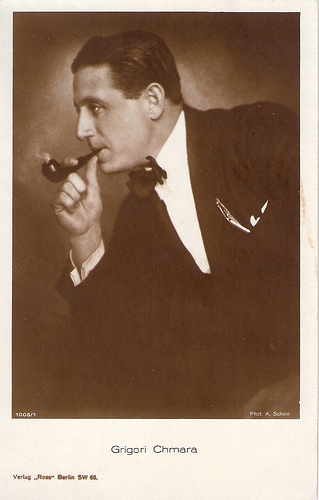
German postcard by Ross Verlag, Berlin, no. 1005/1, 1927-1928. Photo: A. Schein.
The Duse of the silent film
Gregori Chmara, a.k.a. Grigori Chmara, Grigori Khamara and Grégory Chmara, was born in Poltava, Russian Empire (now Ukraine), in 1882 (according to IMDb in 1893).
In 1910 he debuted at the Moscow Art Theatre, getting lead roles from 1912 on.
He made his film debut in the Russian production Sverchok na pechi (Boris Sushkevich, Aleksandr Uralsky, 1915), an adaptation of Charles Dickens' The Cricket on the Hearth. Chmara played opposite Maria Ouspenskaya and Michail Chekhov, a nephew of playwright Anton Chekhov, and both pupils of innovative theatre director Konstantin Stanislavski.
Chmara next played in Yevgeni Bauer's Koroleva ekrana/Queen of the Screen (1916) and some films of Joseph Soiffer.
After the Russian revolution, he moved to Germany, probably around 1921. Chmara became a popular star in Berlin with his gypsy songs, accompanying himself on the guitar. During one of these music nights he conquered Asta Nielsen , the Duse of the silent film. They became lovers, and stayed together for years without ever marrying.
In 1922 Nielsen provided Chmara his first German film role in Der Absturz/Downfall (Ludwig Wolff, 1923), a film produced by Nielsen herself. It was the start of a very productive period in Chmara's career.
In the expressionistic classic Rasknolnikow (Robert Wiene, 1923), he played the title role, surrounded by an all-Russian cast. The film was an adaptation of Fyodor Dostoyevsky's Crime and Punishment.
In I.N.R.I./Crown of Thorns (Robert Wiene, 1923), he played Jesus opposite Asta Nielsen as Maria Magdalena and Henny Porten as Mary. (Remarkable casting: Nielsen & Porten were rival stars in the 1910s.)
After this, seven more films followed with Asta Nielsen , culminating in a small part in Die freudlose Gasse/The Joyless Street (Georg Wilhelm Pabst, 1925). Chmara then did not appear in films for a few years.
When he restarted in 1928 it was not opposite Nielsen anymore. This could be the result of a boycott against Nielsen in 1925-1927 because of her critique of the film industry. The right wing reaction against Die freudlose Gasse might have been another motive for his absence. Hugo Bettauer, the author of the novel on which Die freudlose Gasse was based, was murdered during the shooting of the film. Several countries forbade the film. Critics of the left heralded it instead.
When exactly Nielsen and Chmara did split is unknown. After 1927 Nielsen returned to the stage where she successfully acted for years, apart from her only sound film, Unmögliche Liebe/Crown of Thorns (Erich Waschneck, 1932).
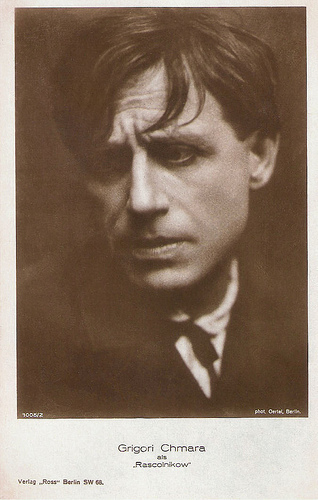
German postcard by Ross Verlag, Berlin, no. 1005/2, 1927-1928. Photo: Oertel, Berlin. Publicity still for Raskolnikow (Robert Wiene, 1923).
Rasputin
In 1928 Gregori Chmara appeared in three German films. In the historical drama Dornenweg einer Fürstin/The Difficult Path of a Princess (Nikolai Larin, Boris Nevolin, 1929), he played Rasputin, the Russian mystic largely responsible for the 1917 collapse of the Romanov dynasty.
Chmara did one film in Poland, the crime mystery Mocny czlowiek/A Strong Man (Henryk Szaro, 1929), in which he had the leading role, and then he moved back to Germany to start making sound films.
He played in both the French and the German version of L'homme qui assassina/Der Mann der den Mord beging/The Man Who Committed the Murder (Curtis Bernhardt, 1930) starring Conrad Veidt .
Films followed like the comedy Peter Voss, der Millionendieb/Peter Voss, the Thief of Millions (Ewald André Dupont, 1932) starring Willi Forst , and Der Diamant des Zaren/The Diamond of the Czar (Max Neufeld, 1932) with Liane Haid .
In the same period, Chmara travelled around with the so-called Group of Prague, which consisted of fled Russian actors. In 1929 for instance they performed in Raskolnikow in Belgrade.
In 1933 Chmara met Lila Kedrova in Paris, during one of his theatre tours and she became his new lover until 1940. He introduced her to the Stanislavski Method. Chmara himself though was handicapped because he refused to learn French, and he thus survived singing in Russian cabarets.
In 1940 he met Vera Volmane, a Russian film journalist, and they became a couple. During and after the war she wrote sketches for him and adaptations of plays. Because of his strong accent Chmara's roles in post-war cinema and theatre were limited to exotic characters, though he also played the classic Russian and Scandinavian authors on stage.
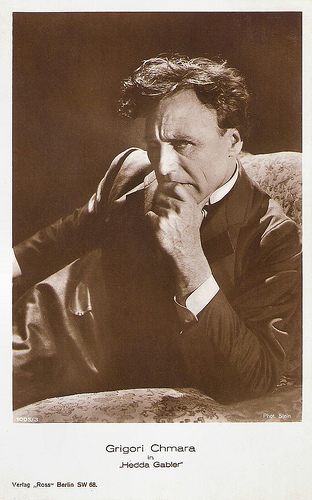
German postcard by Ross Verlag, Berlin, no. 1005/3, 1927-1928. Photo: A. Schein. Publicity still for Hedda Gabler (Franz Eckstein, 1925).
The Stanislavski Method
In post-war cinema, Gregori Chmara had small roles or even bit parts, from Un ami viendra ce soir/A Friend Will Come Tonight (Raymond Bernard, 1946) and Jo-la-Romance (Gilles Grangier, 1949) starring Georges Guétary to the Sartre adaptation Les mains sales/Dirty Hands (Fernand Rivers, Simone Berriau, 1951).
He played Elena's domestic in Elena et les hommes/Paris Does Strange Things (Jean Renoir, 1956) with Ingrid Bergman . He also had a bit part in the Swiss film Die Vier im Jeep/Four in a Jeep (Leopold Lindtberg, 1951), a drama about post-war Vienna, that won the Golden Bear at the first Berlin International Film Festival.
In the 1950s, Chmara was considered as one of the true heirs and pupils of Stanislavski. He gave acting lessons, e.g. to Pierre Brice .
Chmara had occasionally small film roles during the 1960's. These films included Arsène Lupin contre Arsene Lupin/Arsene Lupin vs. Arsene Lupin (Edouard Molinaro, 1962). His last role was a return to Raskolnikow, when he had a small role in Crime et châtiment/Crime and Punishment (Stellio Lorenzi, 1971), a French TV-version of Dostoyevsky's classic novel.
Before it aired, Gregory Chmara died in Paris in 1970. In 1979 Vera Volmane and film critic Charles Ford published Grégory Chmara, l'homme expressif. In 1980 Volmane and Ford introduced the Prix Grégory Chmara, for the best theatre or film actor and actress in a certain role of that year.
A tipsy Prince Cernuwicz played by Gregori Chmara in Der Mann, der den Mord beging/The Man Who Committed the Murder (1930), with Heinrich George and Conrad Veidt . Source: Parysia 77 (YouTube).
Another scene from Der Mann, der den Mord beging/The Man Who Committed the Murder (1930) with Gregori Chmara, Heinrich George and Conrad Veidt . Source: Parysia 77 (YouTube).
Source: , Wikipedia (Danish) and Russie-europe (French).

German postcard by Ross Verlag, Berlin, no. 1005/1, 1927-1928. Photo: A. Schein.
The Duse of the silent film
Gregori Chmara, a.k.a. Grigori Chmara, Grigori Khamara and Grégory Chmara, was born in Poltava, Russian Empire (now Ukraine), in 1882 (according to IMDb in 1893).
In 1910 he debuted at the Moscow Art Theatre, getting lead roles from 1912 on.
He made his film debut in the Russian production Sverchok na pechi (Boris Sushkevich, Aleksandr Uralsky, 1915), an adaptation of Charles Dickens' The Cricket on the Hearth. Chmara played opposite Maria Ouspenskaya and Michail Chekhov, a nephew of playwright Anton Chekhov, and both pupils of innovative theatre director Konstantin Stanislavski.
Chmara next played in Yevgeni Bauer's Koroleva ekrana/Queen of the Screen (1916) and some films of Joseph Soiffer.
After the Russian revolution, he moved to Germany, probably around 1921. Chmara became a popular star in Berlin with his gypsy songs, accompanying himself on the guitar. During one of these music nights he conquered Asta Nielsen , the Duse of the silent film. They became lovers, and stayed together for years without ever marrying.
In 1922 Nielsen provided Chmara his first German film role in Der Absturz/Downfall (Ludwig Wolff, 1923), a film produced by Nielsen herself. It was the start of a very productive period in Chmara's career.
In the expressionistic classic Rasknolnikow (Robert Wiene, 1923), he played the title role, surrounded by an all-Russian cast. The film was an adaptation of Fyodor Dostoyevsky's Crime and Punishment.
In I.N.R.I./Crown of Thorns (Robert Wiene, 1923), he played Jesus opposite Asta Nielsen as Maria Magdalena and Henny Porten as Mary. (Remarkable casting: Nielsen & Porten were rival stars in the 1910s.)
After this, seven more films followed with Asta Nielsen , culminating in a small part in Die freudlose Gasse/The Joyless Street (Georg Wilhelm Pabst, 1925). Chmara then did not appear in films for a few years.
When he restarted in 1928 it was not opposite Nielsen anymore. This could be the result of a boycott against Nielsen in 1925-1927 because of her critique of the film industry. The right wing reaction against Die freudlose Gasse might have been another motive for his absence. Hugo Bettauer, the author of the novel on which Die freudlose Gasse was based, was murdered during the shooting of the film. Several countries forbade the film. Critics of the left heralded it instead.
When exactly Nielsen and Chmara did split is unknown. After 1927 Nielsen returned to the stage where she successfully acted for years, apart from her only sound film, Unmögliche Liebe/Crown of Thorns (Erich Waschneck, 1932).

German postcard by Ross Verlag, Berlin, no. 1005/2, 1927-1928. Photo: Oertel, Berlin. Publicity still for Raskolnikow (Robert Wiene, 1923).
Rasputin
In 1928 Gregori Chmara appeared in three German films. In the historical drama Dornenweg einer Fürstin/The Difficult Path of a Princess (Nikolai Larin, Boris Nevolin, 1929), he played Rasputin, the Russian mystic largely responsible for the 1917 collapse of the Romanov dynasty.
Chmara did one film in Poland, the crime mystery Mocny czlowiek/A Strong Man (Henryk Szaro, 1929), in which he had the leading role, and then he moved back to Germany to start making sound films.
He played in both the French and the German version of L'homme qui assassina/Der Mann der den Mord beging/The Man Who Committed the Murder (Curtis Bernhardt, 1930) starring Conrad Veidt .
Films followed like the comedy Peter Voss, der Millionendieb/Peter Voss, the Thief of Millions (Ewald André Dupont, 1932) starring Willi Forst , and Der Diamant des Zaren/The Diamond of the Czar (Max Neufeld, 1932) with Liane Haid .
In the same period, Chmara travelled around with the so-called Group of Prague, which consisted of fled Russian actors. In 1929 for instance they performed in Raskolnikow in Belgrade.
In 1933 Chmara met Lila Kedrova in Paris, during one of his theatre tours and she became his new lover until 1940. He introduced her to the Stanislavski Method. Chmara himself though was handicapped because he refused to learn French, and he thus survived singing in Russian cabarets.
In 1940 he met Vera Volmane, a Russian film journalist, and they became a couple. During and after the war she wrote sketches for him and adaptations of plays. Because of his strong accent Chmara's roles in post-war cinema and theatre were limited to exotic characters, though he also played the classic Russian and Scandinavian authors on stage.

German postcard by Ross Verlag, Berlin, no. 1005/3, 1927-1928. Photo: A. Schein. Publicity still for Hedda Gabler (Franz Eckstein, 1925).
The Stanislavski Method
In post-war cinema, Gregori Chmara had small roles or even bit parts, from Un ami viendra ce soir/A Friend Will Come Tonight (Raymond Bernard, 1946) and Jo-la-Romance (Gilles Grangier, 1949) starring Georges Guétary to the Sartre adaptation Les mains sales/Dirty Hands (Fernand Rivers, Simone Berriau, 1951).
He played Elena's domestic in Elena et les hommes/Paris Does Strange Things (Jean Renoir, 1956) with Ingrid Bergman . He also had a bit part in the Swiss film Die Vier im Jeep/Four in a Jeep (Leopold Lindtberg, 1951), a drama about post-war Vienna, that won the Golden Bear at the first Berlin International Film Festival.
In the 1950s, Chmara was considered as one of the true heirs and pupils of Stanislavski. He gave acting lessons, e.g. to Pierre Brice .
Chmara had occasionally small film roles during the 1960's. These films included Arsène Lupin contre Arsene Lupin/Arsene Lupin vs. Arsene Lupin (Edouard Molinaro, 1962). His last role was a return to Raskolnikow, when he had a small role in Crime et châtiment/Crime and Punishment (Stellio Lorenzi, 1971), a French TV-version of Dostoyevsky's classic novel.
Before it aired, Gregory Chmara died in Paris in 1970. In 1979 Vera Volmane and film critic Charles Ford published Grégory Chmara, l'homme expressif. In 1980 Volmane and Ford introduced the Prix Grégory Chmara, for the best theatre or film actor and actress in a certain role of that year.
A tipsy Prince Cernuwicz played by Gregori Chmara in Der Mann, der den Mord beging/The Man Who Committed the Murder (1930), with Heinrich George and Conrad Veidt . Source: Parysia 77 (YouTube).
Another scene from Der Mann, der den Mord beging/The Man Who Committed the Murder (1930) with Gregori Chmara, Heinrich George and Conrad Veidt . Source: Parysia 77 (YouTube).
Source: , Wikipedia (Danish) and Russie-europe (French).
Published on October 30, 2014 00:00
October 29, 2014
Gerda Maurus
Austrian actress Gerda Maurus (1903-1968) was a star of the silent screen. With her protruded cheek bones and her forceful look she bewitched many men, including her director Fritz Lang and Nazi Minister Joseph Goebbels.
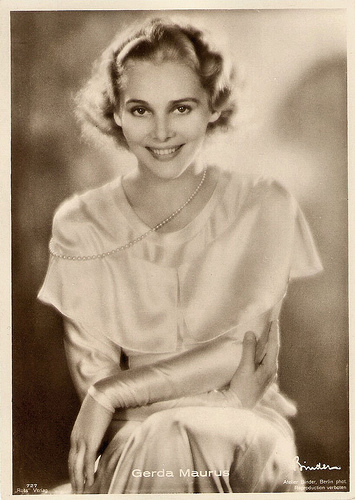
German postcard by Ross Verlag, no. 727, 1925-1926. Photo: Atelier Binder, Berlin.
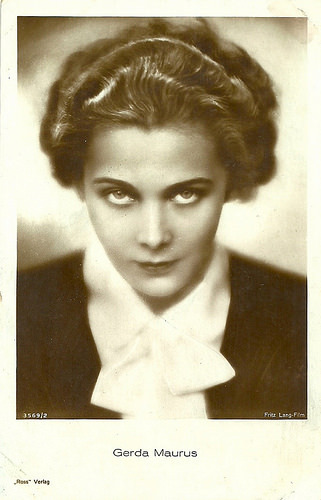
German postcard by Ross Verlag, no. 3569/2, 1928-1929. Photo: Fritz Lang Film.
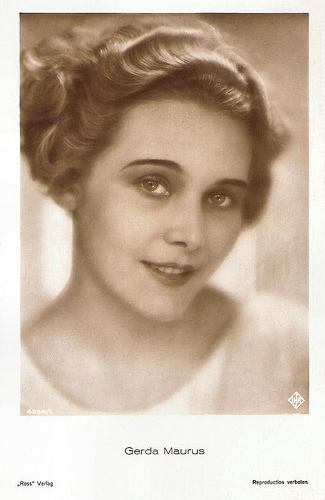
German postcard by Ross Verlag, no. 4254/1, 1929-1930. Photo: Ufa.
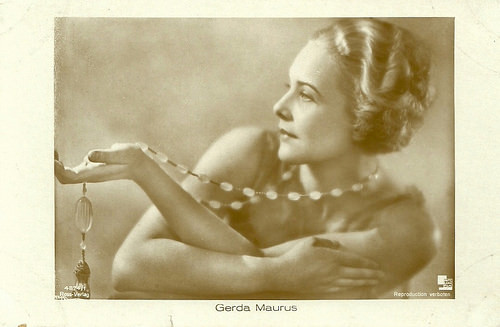
German postcard by Ross Verlag, no. 4874/1, 1929-1930. Photo: Fritz Lang Film.
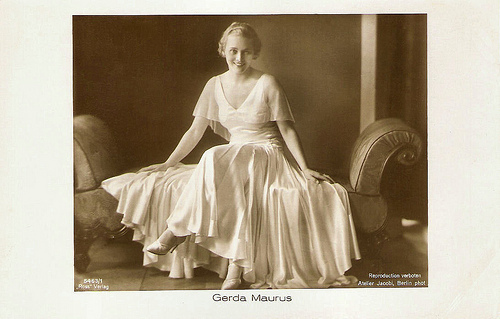
German postcard by Ross Verlag, no. 5463/1, 1930-1931. Photo: Atelier Jacobi, Berlin.
Fritz Lang
Gerda Maurus was born as Gertrud Maria Pfiel in Breitenfurt, Austria, in 1903. She grew up in Wien (Vienna).
In 1918, the only 15 years old Gerda had her first engagement at one of the theatres of Vienna. As a stage actress she worked at the Volkstheater in München (Munich), in Nürnberg (Neurenberg) and from 1926 on at the Deutschen Theater in Berlin.
There she was discovered by director Fritz Lang, who choose her for the female leading role of a Russian spy in his next thriller, Spione/Spies (1928).
Spione was Lang’s first independent production. The years-ahead-of-its-time plotline involves Russian espionage activity in London. The mastermind is Haghi ( Rudolph Klein-Rogge ), a supposedly respectable carnival sideshow entertainer. Heading the good guys is Agent 326 ( Willy Fritsch ), with the help of defecting Russian spy Sonya, played by Gerda Maurus.
The film moves swiftly to several potential climaxes, each one more exciting than its predecessor. According to Hal Erickson of AllMovie , “Haghi's ultimate demise is a superbly staged Pirandellian vignette. Anticipating Citizen Kane by a dozen years, director Lang dispenses with all transitional dissolves and fade-outs, flat-cutting territory from one scene to another”.
Gerda fascinated him thus that Lang finished his relationship with his partner and wife, Thea von Harbou, who had co-scripted Spione with him.
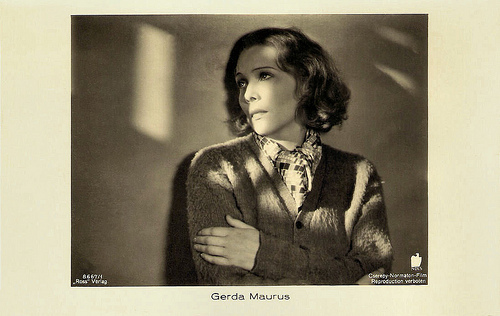
German postcard by Ross Verlag, no. 8667/1, 1933-1934. Photo: Cserepy-Normation-Film / NDLS.
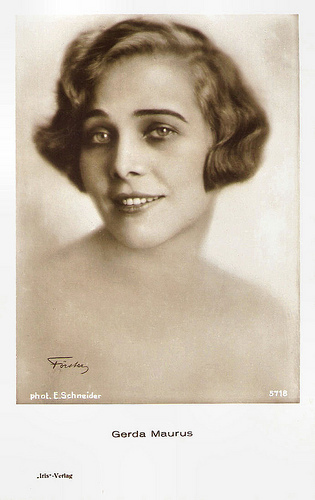
Austrian postcard by Iris-Verlag, no. 5718. Photo: Förster / E. Schneider.
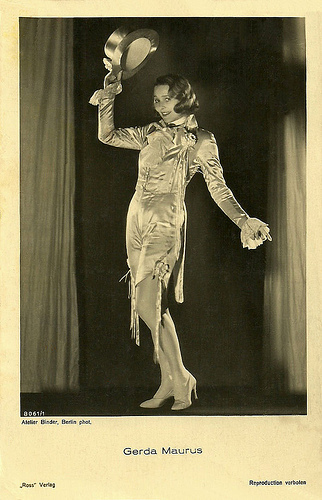
German postcard by Ross Verlag, no. 8061/1, 1933-1934. Photo: Atelier Binder, Berlin.
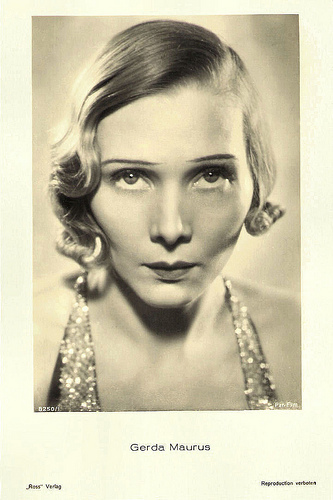
German postcard by Ross Verlag, no. 8250/1, 1933-1934. Photo: Pan Film.
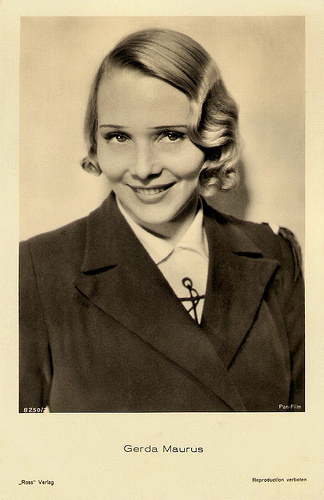
German postcard by Ross Verlag, no. 8250/2, 1933-1934. Photo: Pan Film.
Countdown Before Blast-off
For Gerda Maurus her film debut was also her breakthrough. Her next film was the science-fiction film Frau im Mond/Woman in the Moon (1929), again with Willy Fritsch and again directed by Fritz Lang.
Frau im Mond is one of the first major films to dwell upon the possibility of space travel. Hal Erickson writes that it is, “like many of its modern-day counterparts, more successful on a special-effects level than it is in terms of character development”.
Among the many prescient aspects of the film is its use of a countdown before blast-off and its depiction of the effects of centrifugal force upon the lunar passengers. Willy Ley, later a leading light of the U.S. space program, served as technical adviser. Reportedly, Adolf Hitler was so overwhelmed by Frau im Mond that he used the rocket depicted in the film as the prototype for the dreaded V1 and V2 assault missiles.
In Frau im Mond Maurus joined the extra-terrestrial expedition in search of gold on the moon. And again she was a huge success.
The arrival of sound did certainly not finish Maurus’ film career. She starred as a film diva in the intricate murder mystery Der Schuß im Tonfilmatelier/The Shot in The Talker Studio (Alfred Zeisler, 1930) set in the Ufa film studio in Babelsberg.
In Der Weisse Dämon/White Demon (Kurt Gerron, 1932) she featured as a drug-addicted opera star, opposite Hans Albers and Peter Lorre .
During the Nazi period, the actress had a close contact with Propaganda Minister Joseph Goebbels. After Fritz Lang had emigrated in 1933, she reportedly often visited his salon. Her charms did not only turn Goebbels on but also the communist dramatist Friedrich Wolf.
In 1937 she married Robert A. Stemmle, who directed her in the film Daphne und der Diplomat/Daphne and the Diplomat (1937). They would have a daughter, Philine, born in 1943.
Maurus appeared in more popular films like Der Dschungel ruft/The Call of the Jungle ( Harry Piel , 1936), Grenzfeuer/Boundary Fire (Alois Johannes Lippl, 1939) and Die gute Sieben/The Lucky Seven ( Wolfgang Liebeneiner , 1940), but none of these films came near to the great successes of her first films with Fritz Lang.
She concentrated on stage work and performed in Berlin, Wien, München and Düsseldorf. After 1945 Maurus played in only two more German pictures: the comedies Die Freunde meiner Frau/My Wife’s Friends (Hans Deppe, 1949) and Die kleine Stadt will schlafen gehen/The Little Town Wants To Sleep (Hans H. König, 1953).
Later she appeared in the TV-plays Wir sind noch einmal davongekommen/The Skin of our Teeth (Karl-Heinz Stroux, 1951) and one year later in Vor Sonnenuntergang/Before Sunrise (Karl-Heinz Stroux, 1962). Her last TV appearance was in a supporting part in Das Käthchen von Heilbronn/Cathy of Heibronn (1968), an adaptation of the classic play by Heinrich von Kleist.
Gerda Maurus died in 1968 in Düsseldorf, Germany.
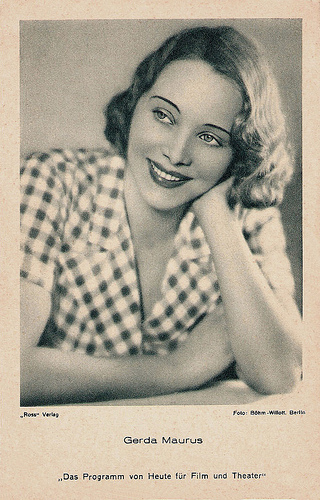
German postcard by Das Programm von Heute für Film und Theater / Ross Verlag, Berlin. Photo: Böhm-Willott, Berlin. Collection: Miss Mertens.
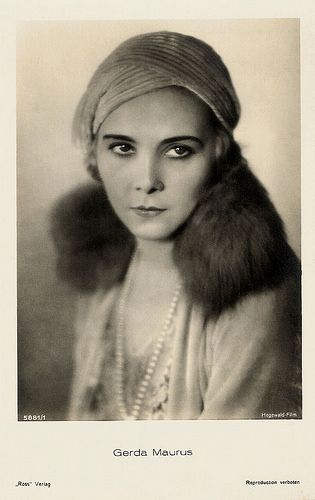
German postcard by Ross Verlag, no. 5881/1, 1930-1931. Photo: Hegewald Film.
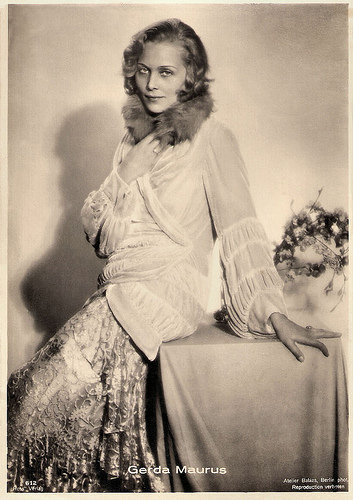
German postcard by Ross Verlag, no. 612. Photo: Atelier Balázs, Berlin.
The great Rudolf Klein-Rogge in the climax scene of Spione (1928). Source: Manferot (YouTube).
Launch of the rocket scene from Frau im Mond (1929). Source: Manferot (YouTube).
Landing of the rocket scene from Frau im Mond (1929). Source: Manferot (YouTube).
Sources: Thomas Staedeli (Cyranos), Hal Erickson (AllMovie), Stephanie D'heil (Steffi-line - German), Wikipedia (German), and .

German postcard by Ross Verlag, no. 727, 1925-1926. Photo: Atelier Binder, Berlin.

German postcard by Ross Verlag, no. 3569/2, 1928-1929. Photo: Fritz Lang Film.

German postcard by Ross Verlag, no. 4254/1, 1929-1930. Photo: Ufa.

German postcard by Ross Verlag, no. 4874/1, 1929-1930. Photo: Fritz Lang Film.

German postcard by Ross Verlag, no. 5463/1, 1930-1931. Photo: Atelier Jacobi, Berlin.
Fritz Lang
Gerda Maurus was born as Gertrud Maria Pfiel in Breitenfurt, Austria, in 1903. She grew up in Wien (Vienna).
In 1918, the only 15 years old Gerda had her first engagement at one of the theatres of Vienna. As a stage actress she worked at the Volkstheater in München (Munich), in Nürnberg (Neurenberg) and from 1926 on at the Deutschen Theater in Berlin.
There she was discovered by director Fritz Lang, who choose her for the female leading role of a Russian spy in his next thriller, Spione/Spies (1928).
Spione was Lang’s first independent production. The years-ahead-of-its-time plotline involves Russian espionage activity in London. The mastermind is Haghi ( Rudolph Klein-Rogge ), a supposedly respectable carnival sideshow entertainer. Heading the good guys is Agent 326 ( Willy Fritsch ), with the help of defecting Russian spy Sonya, played by Gerda Maurus.
The film moves swiftly to several potential climaxes, each one more exciting than its predecessor. According to Hal Erickson of AllMovie , “Haghi's ultimate demise is a superbly staged Pirandellian vignette. Anticipating Citizen Kane by a dozen years, director Lang dispenses with all transitional dissolves and fade-outs, flat-cutting territory from one scene to another”.
Gerda fascinated him thus that Lang finished his relationship with his partner and wife, Thea von Harbou, who had co-scripted Spione with him.

German postcard by Ross Verlag, no. 8667/1, 1933-1934. Photo: Cserepy-Normation-Film / NDLS.

Austrian postcard by Iris-Verlag, no. 5718. Photo: Förster / E. Schneider.

German postcard by Ross Verlag, no. 8061/1, 1933-1934. Photo: Atelier Binder, Berlin.

German postcard by Ross Verlag, no. 8250/1, 1933-1934. Photo: Pan Film.

German postcard by Ross Verlag, no. 8250/2, 1933-1934. Photo: Pan Film.
Countdown Before Blast-off
For Gerda Maurus her film debut was also her breakthrough. Her next film was the science-fiction film Frau im Mond/Woman in the Moon (1929), again with Willy Fritsch and again directed by Fritz Lang.
Frau im Mond is one of the first major films to dwell upon the possibility of space travel. Hal Erickson writes that it is, “like many of its modern-day counterparts, more successful on a special-effects level than it is in terms of character development”.
Among the many prescient aspects of the film is its use of a countdown before blast-off and its depiction of the effects of centrifugal force upon the lunar passengers. Willy Ley, later a leading light of the U.S. space program, served as technical adviser. Reportedly, Adolf Hitler was so overwhelmed by Frau im Mond that he used the rocket depicted in the film as the prototype for the dreaded V1 and V2 assault missiles.
In Frau im Mond Maurus joined the extra-terrestrial expedition in search of gold on the moon. And again she was a huge success.
The arrival of sound did certainly not finish Maurus’ film career. She starred as a film diva in the intricate murder mystery Der Schuß im Tonfilmatelier/The Shot in The Talker Studio (Alfred Zeisler, 1930) set in the Ufa film studio in Babelsberg.
In Der Weisse Dämon/White Demon (Kurt Gerron, 1932) she featured as a drug-addicted opera star, opposite Hans Albers and Peter Lorre .
During the Nazi period, the actress had a close contact with Propaganda Minister Joseph Goebbels. After Fritz Lang had emigrated in 1933, she reportedly often visited his salon. Her charms did not only turn Goebbels on but also the communist dramatist Friedrich Wolf.
In 1937 she married Robert A. Stemmle, who directed her in the film Daphne und der Diplomat/Daphne and the Diplomat (1937). They would have a daughter, Philine, born in 1943.
Maurus appeared in more popular films like Der Dschungel ruft/The Call of the Jungle ( Harry Piel , 1936), Grenzfeuer/Boundary Fire (Alois Johannes Lippl, 1939) and Die gute Sieben/The Lucky Seven ( Wolfgang Liebeneiner , 1940), but none of these films came near to the great successes of her first films with Fritz Lang.
She concentrated on stage work and performed in Berlin, Wien, München and Düsseldorf. After 1945 Maurus played in only two more German pictures: the comedies Die Freunde meiner Frau/My Wife’s Friends (Hans Deppe, 1949) and Die kleine Stadt will schlafen gehen/The Little Town Wants To Sleep (Hans H. König, 1953).
Later she appeared in the TV-plays Wir sind noch einmal davongekommen/The Skin of our Teeth (Karl-Heinz Stroux, 1951) and one year later in Vor Sonnenuntergang/Before Sunrise (Karl-Heinz Stroux, 1962). Her last TV appearance was in a supporting part in Das Käthchen von Heilbronn/Cathy of Heibronn (1968), an adaptation of the classic play by Heinrich von Kleist.
Gerda Maurus died in 1968 in Düsseldorf, Germany.

German postcard by Das Programm von Heute für Film und Theater / Ross Verlag, Berlin. Photo: Böhm-Willott, Berlin. Collection: Miss Mertens.

German postcard by Ross Verlag, no. 5881/1, 1930-1931. Photo: Hegewald Film.

German postcard by Ross Verlag, no. 612. Photo: Atelier Balázs, Berlin.
The great Rudolf Klein-Rogge in the climax scene of Spione (1928). Source: Manferot (YouTube).
Launch of the rocket scene from Frau im Mond (1929). Source: Manferot (YouTube).
Landing of the rocket scene from Frau im Mond (1929). Source: Manferot (YouTube).
Sources: Thomas Staedeli (Cyranos), Hal Erickson (AllMovie), Stephanie D'heil (Steffi-line - German), Wikipedia (German), and .
Published on October 29, 2014 00:00
October 27, 2014
Astrea
Astrea (?-?) was the enigmatic female ‘forzuta’ of Italian silent cinema. She had a short film career and made only four films in 1919 and 1920.
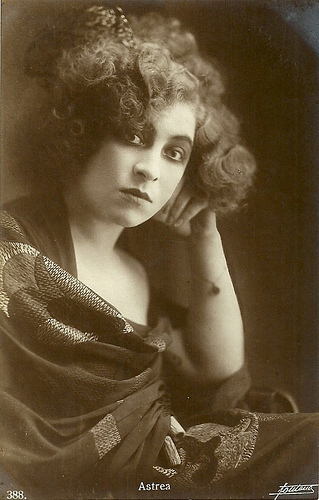
Italian postcard, no. 388. Photo: Fontana.
Goddess of Justice
Nothing is known about Astrea’s dates of birth and death, nor her original name. Some say she was a Venetian countess originally, others claim she came from the circus, the last name of Barbieri is mentioned.
Amongst the various male forzuti or strongmen of Italian cinema of the late 1910s there were few female versions, but most have stayed unknown till recently, e.g. Linda Albertini, Ethel Joyce, Gisa-Liana Doria and Piera Bouvier.
Thanks to a print at the Milanese film archive of the film Justitia, Astrea WAS known, though her biography has remained as misty as the London fog.
Astrea’s name refers to a goddess of Justice in Greek mythology, who in the so-called Iron Age left Earth as it had become too criminal and debauched.
The film Astrea (so Justice returned to Earth) was a sturdy and sportive female athlete, defender of the weak and the fighter of crime, helped by her comical sidekick Polidor (Ferdinando Guillaume).
In her short career Astrea only made four films, all within the athletic-acrobatic genre of Italian silent film, but here combining it with comedy too.
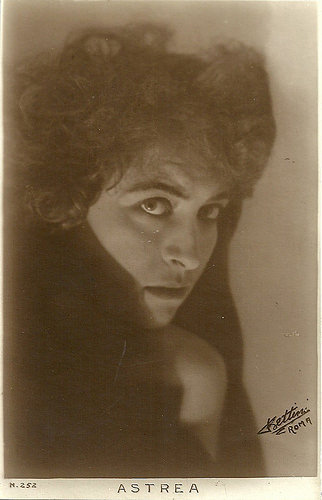
Italian postcard, no. 252. Photo: Bettini, Roma.
Feeding her enemies bit by bit to the pigs
Astrea first acted in a rather heavy anti-Austrian propaganda film, La riscossa delle maschere/The rescue of the masks (Leopoldo Carlucci, 1919, though IMDb writes the director was Gustavo Zaremba de Jaracewski), co-starring Gian Paolo Rosmino.
In the film all Italian masks are reanimated by Astrea to rescue the Italians from the Austrians. The film was made after the defeat at Caporetto and was supposed to boost morale, but according to IMDb it was released after the war ended.
Astrea behaves like a real killer, drowning spies, feeding her enemies bit by bit to the pigs, with a violence and sadism unknown to her male competitors, mostly good-hearted giants.
In her next film Justitia (1920) the tone was much milder. The film was directed by Ferdinando Guillaume, while Astrea, Guillaume’s relatives and he himself acted in the film.
Astrea plays a double role of well-groomed and dressed princess, who cliché-like, is as well a retributive yet also big-hearted avenger, who protects a lovers’ couple hunted by the usual bad guys.
While the Italian press praised her as strong, athletic and lady-like at the same time, the British journal The Bioscope called her ‘a herculean woman with the defiance of a Houdini, a female knight roaming the world to set wrong situations right with the force of her muscles.'
Anyway, Justitia had a wide international distribution and was a big success, partly under the title 'Astrea'. With actor-director Ferdinando Guillaume, Astrea did two more films, L’ultima fiaba/The last fairy tale (1920) and I creatori dell’impossibile/The creators of the impossible (1922), presumably lost.
Vittorio Martinelli writes that the latter was a rather far-fetched farce, ‘so Countess B. retreated to the shadows, silently, leaving her crown of the queen of muscles, not permitting anybody to touch her privacy’.
NB. A French print titled 'Astrea' was found recently and shown at the 2010 Bologna festival Il Cinema Ritrovato; it might be L’ultima fiaba.
Sources: Alberto Farassino/Tatti Sanguineti (Gli uomini forti - Italian), Michele Giordano (Giganti buoni - Italian), and .

Italian postcard, no. 388. Photo: Fontana.
Goddess of Justice
Nothing is known about Astrea’s dates of birth and death, nor her original name. Some say she was a Venetian countess originally, others claim she came from the circus, the last name of Barbieri is mentioned.
Amongst the various male forzuti or strongmen of Italian cinema of the late 1910s there were few female versions, but most have stayed unknown till recently, e.g. Linda Albertini, Ethel Joyce, Gisa-Liana Doria and Piera Bouvier.
Thanks to a print at the Milanese film archive of the film Justitia, Astrea WAS known, though her biography has remained as misty as the London fog.
Astrea’s name refers to a goddess of Justice in Greek mythology, who in the so-called Iron Age left Earth as it had become too criminal and debauched.
The film Astrea (so Justice returned to Earth) was a sturdy and sportive female athlete, defender of the weak and the fighter of crime, helped by her comical sidekick Polidor (Ferdinando Guillaume).
In her short career Astrea only made four films, all within the athletic-acrobatic genre of Italian silent film, but here combining it with comedy too.

Italian postcard, no. 252. Photo: Bettini, Roma.
Feeding her enemies bit by bit to the pigs
Astrea first acted in a rather heavy anti-Austrian propaganda film, La riscossa delle maschere/The rescue of the masks (Leopoldo Carlucci, 1919, though IMDb writes the director was Gustavo Zaremba de Jaracewski), co-starring Gian Paolo Rosmino.
In the film all Italian masks are reanimated by Astrea to rescue the Italians from the Austrians. The film was made after the defeat at Caporetto and was supposed to boost morale, but according to IMDb it was released after the war ended.
Astrea behaves like a real killer, drowning spies, feeding her enemies bit by bit to the pigs, with a violence and sadism unknown to her male competitors, mostly good-hearted giants.
In her next film Justitia (1920) the tone was much milder. The film was directed by Ferdinando Guillaume, while Astrea, Guillaume’s relatives and he himself acted in the film.
Astrea plays a double role of well-groomed and dressed princess, who cliché-like, is as well a retributive yet also big-hearted avenger, who protects a lovers’ couple hunted by the usual bad guys.
While the Italian press praised her as strong, athletic and lady-like at the same time, the British journal The Bioscope called her ‘a herculean woman with the defiance of a Houdini, a female knight roaming the world to set wrong situations right with the force of her muscles.'
Anyway, Justitia had a wide international distribution and was a big success, partly under the title 'Astrea'. With actor-director Ferdinando Guillaume, Astrea did two more films, L’ultima fiaba/The last fairy tale (1920) and I creatori dell’impossibile/The creators of the impossible (1922), presumably lost.
Vittorio Martinelli writes that the latter was a rather far-fetched farce, ‘so Countess B. retreated to the shadows, silently, leaving her crown of the queen of muscles, not permitting anybody to touch her privacy’.
NB. A French print titled 'Astrea' was found recently and shown at the 2010 Bologna festival Il Cinema Ritrovato; it might be L’ultima fiaba.
Sources: Alberto Farassino/Tatti Sanguineti (Gli uomini forti - Italian), Michele Giordano (Giganti buoni - Italian), and .
Published on October 27, 2014 23:00
October 26, 2014
Anastasiya Vertinskaya
Anastasiya Vertinskaya (1944) is a popular Russian actress. She became a national celebrity with her roles as Assol in Alye parusa/Scarlet Sails (Aleksandr Ptushko, 1961) and as Ophelia in Gamlet/Hamlet (Grigori Kozintsev, 1964).
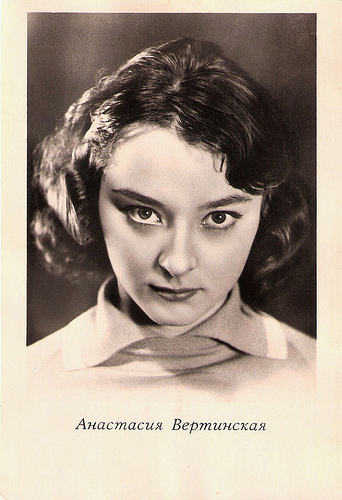
Russian postcard by Izdanije Byuro Propogandy Sovietskogo Kinoiskusstva, no. 4176, 1963. Retail price: 8 Kop.
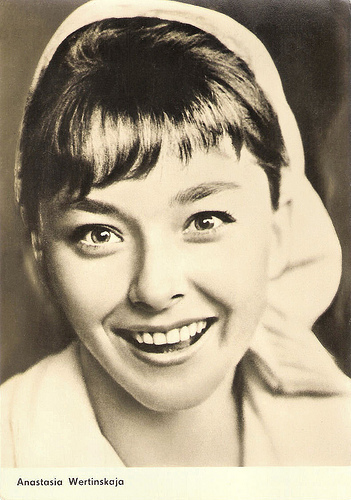
East-German postcard by VEB Progress, Berlin, no. 2.207. Retail price: 0,20 DM. Photo: Schwarz.
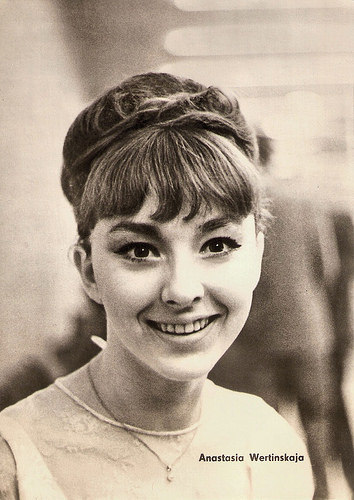
East-German postcard by VEB Progress, Berlin, no. 3187. Retail price: 0,20 DM. Photo: Balinski.
Emotional Trauma
Anastasiya Alexandrovna Vertinskaya (Russian: Анастасия Александровна Вертинская) was born in Moscow, Soviet Union (now Russia), in 1944.
Her father, Aleksandr Vertinsky, was a famous Russian actor, singer and songwriter, who returned from his emigration in China to Moscow during the Second World War. Her mother, Lidiya Vertinskaya (née Lidia Vladimirovna Tsirgvava), was also a Russian émigré who was born into a Georgian-Russian family in Kharbin.
Young Anastasiya (or Anastasia) and her sister Marianna, who would become an actress too, were brought up in a multi-lingual family where they enjoyed an intellectually stimulating environment, and the highly cultural atmosphere of their parents circle.
Anastasia Vertinskaya was fond of her father, who invested much of his talent and energy in his daughter's education. Her famous father died when she was 14.
She suffered from an emotional trauma that casted an influence on her most important film roles, which she played at the age of 15 to 19.
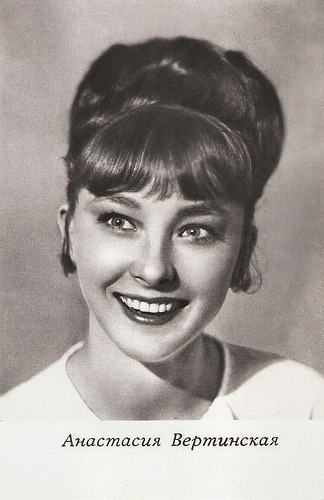
Russian postcard, no. 4176, 1967. This postcard was printed in an edition of 100.000 cards.
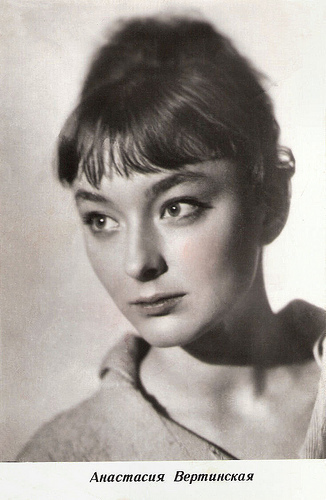
Russian postcard by Izdanije Byuro Propogandy Sovietskogo Kinoiskusstva, no. A 07454. Photo: Photostudio Dinamo. This postcard was printed in an edition of 10.000 cards. The price was 8 kop.
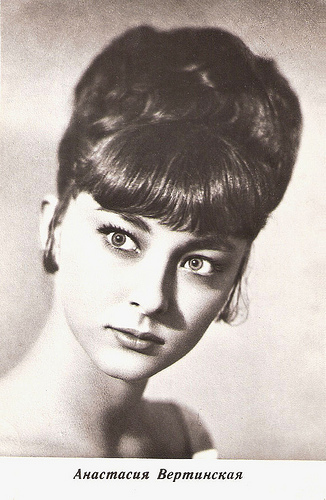
Russian postcard by Izdanije Byuro Propogandy Sovietskogo Kinoiskusstva, no. M 17432 31, 1967. Photo: G. Vajlja. This postcard was printed in an edition of 150.000 cards. Retail price: 8 Kop.
Instant Celebrity
As a schoolgirl of 15, Anastasiya Vertinskaya made her film debut starring in Alye parusa/Scarlet Sails (Aleksandr Ptushko, 1961). The film is based on Alexander Grin (or: Green)'s 1923 adventure novel of the same name.
She portrayed love-torn village girl Assol. As a child, she encounters an old man who claims to be a wizard and promises the girl that one day a prince will come on a ship with scarlet sails to carry her away. The villagers scoff but Assol believes her dream will come true one day, and yes....
This film made her an instant celebrity in the Soviet Union. Alongside Vertinskaya, the film employed many of the present and future stars of the Soviet cinema, including Vasily Lanovoy, Ivan Pereverzev, Sergey Martinson, and Oleg Anofriev.
The next year she co-starred as Guttieres, a young woman in love with an amphibian man in Chelovek-Amfibiya/The Amphibian Man (Gennadi Kazansky, Vladimir Chebotaryov, 1962). The successful film was based on the Alexander Belyayev's book of the same name.
In the same year the actress joined the troupe of the Pushkin Theatre in Moscow. This meant that from then on she had to continuously tour the country with the then popular so-called ‘theatre brigades’.
Vertinskaya shot to international fame starring in another dramatic role as Ophelia opposite Innokenti Smoktunovsky in Gamlet/Hamlet (1964) - a well-known adaptation of the Shakespearean play, directed by Grigori Kozintsev.
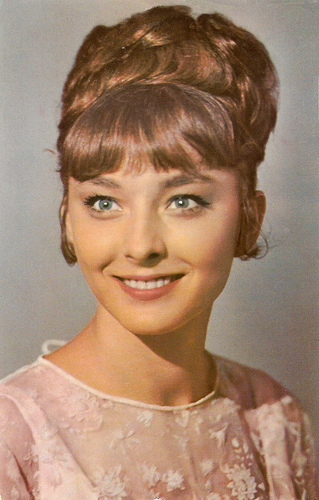
Russian postcard by Izdanije Byuro Propogandy Sovietskogo Kinoiskusstva, no. A 11231, 1966. Photo: G. Vajlja. This postcard was printed in an edition of 100.000 cards. The price was 8 kop.
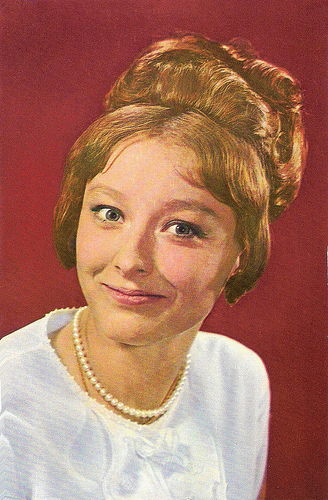
Russian postcard by Izdanije Byuro Propogandy Sovietskogo Kinoiskusstva, nr. A 10674, 1967. This postcard was printed in an edition of 200.000 cards. Retail price: 8 Kop.
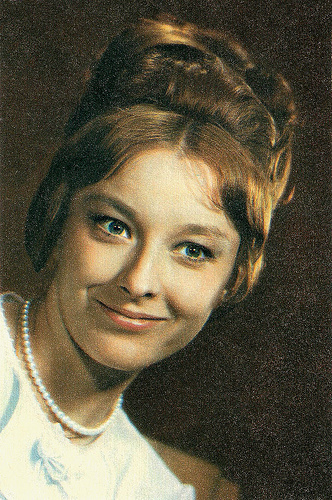
Russian postcard by Izdanije Byuro Propogandy Sovietskogo Kinoiskusstva, nr. M 27929, 1968. This postcard was printed in an edition of 185.000 cards. Retail price: 8 kop.
People's Artist of the RSFSR
Anastasiya Vertinskaya attended the Mikhail Shchepkin Higher Theatre College. Among her fellow students was Nikita Mikhalkov : they fell in love and married in 1966, only to be divorced three years later.
She graduated in 1967 and a year later she began to work at the Sovremennik Theatre in Moscow. From 1980, she was engaged at the Moscow Art Theatre. Her most acclaimed stage appearances were in plays by Anton Chekhov, as Nina in The Seagull and as Elena in Uncle Vanya.
In a theatrical experiment by director Anatoli Efros at Taganka, she appeared in two roles: as Prospero and Ariel in William Shakespeare's The Tempest. In 1989 she portrayed her father, Aleksandr Vertinsky, in a show that she also wrote and directed to mark the centennial birthday anniversary of her father.
While still in the Shchepkin College, Vertinskaya got a role of petite Princess Lisa Bolkonsky in the epic adaptation of Leo Tolstoy’s Voyna i mir/War and Peace (Sergei Bondarchuk, 1967). According to Wikipedia , it was her highly sensual, touchingly naïve portrayal that added this character a new, humane dimension.
In the cinema she also played supporting roles as Kitty in Anna Karenina (Aleksandr Zarkhi, 1967), and as one of the lovers in Vlyublyonnye/Tenderness (Elyer Ishmukhamedov, 1969).
Other notable films were Ne goryuy/Don't Grieve (Georgi Daneliya, 1969), Sluchay s Polyninym/The Polunin Case (Aleksei Sakharov, 1970), Ten/Shadow (Nadezhda Kosheverova, 1971) based on a story by Hans Christian Andersen, Bezymyannaya zvezda/An Unnamed Star (Mikhail Kozakov, 1978), and the Mark Twain adaptation Novye priklyucheniya yanki pri dvore korolya Artura/New Adventures of a Yankee in the Court of King Arthur (Viktor Gres, 1988).
Outside of her film career she taught acting in Oxford and in the European film school in Switzerland; she also held a master class at the Comédie-Française (Théâtre de la Républic) and at the Chekhov's school in Paris.
She was designated People's Artist of the Russian Soviet Federative Socialist Republic (RSFSR) in 1978. She is also a recipient of the Order of Honour (2005) and the Order of Friendship (2010) of the Russian Federation.
Since 1991 Anastasiya Vertinskaya has been running the Charitable Foundation for Actors, which supports such cultural landmarks as the home of Boris Pasternak and the museum of Anton Chekhov as well as many other cultural projects and individual actors and filmmakers.
During the 1990s, she completed restoration of her father's historic recordings for a CD release. Her most recent films are Zazda strasti/Thirst of passion (Andrey Kharitonov, 1991), Master i Margarita/Master and Margareth (Yuri Kara, 1994), and Bremenskie muzykanty/The Bremen Town Musicians (Aleksandr Abdulov, 2001), based on the fairy tale by the brothers Grimm.
Anastasiya Vertinskaya was married to film director and actor Nikita Mikhalkov . Their son, Stepan Mikhalkov (1967), is also a filmmaker. She also has a daughter, Manana (1969), with actor Mikhail Kozakov.
Anastasiya Vertinskaya lives and works in Moscow. In 2010 Vertinskaya published a book of poetry she'd been working on for five years. She's also involved in her son Stepan Mikhalkov's restaurant business in Moscow, her passion for culinary art being well known.
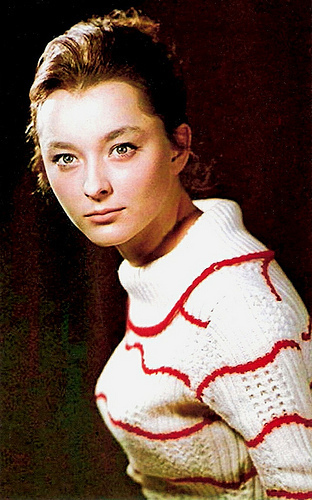
Russian postcard by Izdanije Byuro Propogandy Sovietskogo Kinoiskusstva.
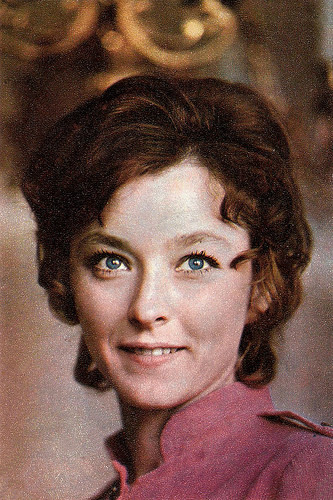
Russian postcard by Izdanije Byuro Propogandy Sovietskogo Kinoiskusstva, no 1574, 1972. This postcard was printed in an edition of 200.000 cards. Retail price: 5 Kop.
Sources: (IMDb), Peoples.ru (Russian), Wikipedia, and .

Russian postcard by Izdanije Byuro Propogandy Sovietskogo Kinoiskusstva, no. 4176, 1963. Retail price: 8 Kop.

East-German postcard by VEB Progress, Berlin, no. 2.207. Retail price: 0,20 DM. Photo: Schwarz.

East-German postcard by VEB Progress, Berlin, no. 3187. Retail price: 0,20 DM. Photo: Balinski.
Emotional Trauma
Anastasiya Alexandrovna Vertinskaya (Russian: Анастасия Александровна Вертинская) was born in Moscow, Soviet Union (now Russia), in 1944.
Her father, Aleksandr Vertinsky, was a famous Russian actor, singer and songwriter, who returned from his emigration in China to Moscow during the Second World War. Her mother, Lidiya Vertinskaya (née Lidia Vladimirovna Tsirgvava), was also a Russian émigré who was born into a Georgian-Russian family in Kharbin.
Young Anastasiya (or Anastasia) and her sister Marianna, who would become an actress too, were brought up in a multi-lingual family where they enjoyed an intellectually stimulating environment, and the highly cultural atmosphere of their parents circle.
Anastasia Vertinskaya was fond of her father, who invested much of his talent and energy in his daughter's education. Her famous father died when she was 14.
She suffered from an emotional trauma that casted an influence on her most important film roles, which she played at the age of 15 to 19.

Russian postcard, no. 4176, 1967. This postcard was printed in an edition of 100.000 cards.

Russian postcard by Izdanije Byuro Propogandy Sovietskogo Kinoiskusstva, no. A 07454. Photo: Photostudio Dinamo. This postcard was printed in an edition of 10.000 cards. The price was 8 kop.

Russian postcard by Izdanije Byuro Propogandy Sovietskogo Kinoiskusstva, no. M 17432 31, 1967. Photo: G. Vajlja. This postcard was printed in an edition of 150.000 cards. Retail price: 8 Kop.
Instant Celebrity
As a schoolgirl of 15, Anastasiya Vertinskaya made her film debut starring in Alye parusa/Scarlet Sails (Aleksandr Ptushko, 1961). The film is based on Alexander Grin (or: Green)'s 1923 adventure novel of the same name.
She portrayed love-torn village girl Assol. As a child, she encounters an old man who claims to be a wizard and promises the girl that one day a prince will come on a ship with scarlet sails to carry her away. The villagers scoff but Assol believes her dream will come true one day, and yes....
This film made her an instant celebrity in the Soviet Union. Alongside Vertinskaya, the film employed many of the present and future stars of the Soviet cinema, including Vasily Lanovoy, Ivan Pereverzev, Sergey Martinson, and Oleg Anofriev.
The next year she co-starred as Guttieres, a young woman in love with an amphibian man in Chelovek-Amfibiya/The Amphibian Man (Gennadi Kazansky, Vladimir Chebotaryov, 1962). The successful film was based on the Alexander Belyayev's book of the same name.
In the same year the actress joined the troupe of the Pushkin Theatre in Moscow. This meant that from then on she had to continuously tour the country with the then popular so-called ‘theatre brigades’.
Vertinskaya shot to international fame starring in another dramatic role as Ophelia opposite Innokenti Smoktunovsky in Gamlet/Hamlet (1964) - a well-known adaptation of the Shakespearean play, directed by Grigori Kozintsev.

Russian postcard by Izdanije Byuro Propogandy Sovietskogo Kinoiskusstva, no. A 11231, 1966. Photo: G. Vajlja. This postcard was printed in an edition of 100.000 cards. The price was 8 kop.

Russian postcard by Izdanije Byuro Propogandy Sovietskogo Kinoiskusstva, nr. A 10674, 1967. This postcard was printed in an edition of 200.000 cards. Retail price: 8 Kop.

Russian postcard by Izdanije Byuro Propogandy Sovietskogo Kinoiskusstva, nr. M 27929, 1968. This postcard was printed in an edition of 185.000 cards. Retail price: 8 kop.
People's Artist of the RSFSR
Anastasiya Vertinskaya attended the Mikhail Shchepkin Higher Theatre College. Among her fellow students was Nikita Mikhalkov : they fell in love and married in 1966, only to be divorced three years later.
She graduated in 1967 and a year later she began to work at the Sovremennik Theatre in Moscow. From 1980, she was engaged at the Moscow Art Theatre. Her most acclaimed stage appearances were in plays by Anton Chekhov, as Nina in The Seagull and as Elena in Uncle Vanya.
In a theatrical experiment by director Anatoli Efros at Taganka, she appeared in two roles: as Prospero and Ariel in William Shakespeare's The Tempest. In 1989 she portrayed her father, Aleksandr Vertinsky, in a show that she also wrote and directed to mark the centennial birthday anniversary of her father.
While still in the Shchepkin College, Vertinskaya got a role of petite Princess Lisa Bolkonsky in the epic adaptation of Leo Tolstoy’s Voyna i mir/War and Peace (Sergei Bondarchuk, 1967). According to Wikipedia , it was her highly sensual, touchingly naïve portrayal that added this character a new, humane dimension.
In the cinema she also played supporting roles as Kitty in Anna Karenina (Aleksandr Zarkhi, 1967), and as one of the lovers in Vlyublyonnye/Tenderness (Elyer Ishmukhamedov, 1969).
Other notable films were Ne goryuy/Don't Grieve (Georgi Daneliya, 1969), Sluchay s Polyninym/The Polunin Case (Aleksei Sakharov, 1970), Ten/Shadow (Nadezhda Kosheverova, 1971) based on a story by Hans Christian Andersen, Bezymyannaya zvezda/An Unnamed Star (Mikhail Kozakov, 1978), and the Mark Twain adaptation Novye priklyucheniya yanki pri dvore korolya Artura/New Adventures of a Yankee in the Court of King Arthur (Viktor Gres, 1988).
Outside of her film career she taught acting in Oxford and in the European film school in Switzerland; she also held a master class at the Comédie-Française (Théâtre de la Républic) and at the Chekhov's school in Paris.
She was designated People's Artist of the Russian Soviet Federative Socialist Republic (RSFSR) in 1978. She is also a recipient of the Order of Honour (2005) and the Order of Friendship (2010) of the Russian Federation.
Since 1991 Anastasiya Vertinskaya has been running the Charitable Foundation for Actors, which supports such cultural landmarks as the home of Boris Pasternak and the museum of Anton Chekhov as well as many other cultural projects and individual actors and filmmakers.
During the 1990s, she completed restoration of her father's historic recordings for a CD release. Her most recent films are Zazda strasti/Thirst of passion (Andrey Kharitonov, 1991), Master i Margarita/Master and Margareth (Yuri Kara, 1994), and Bremenskie muzykanty/The Bremen Town Musicians (Aleksandr Abdulov, 2001), based on the fairy tale by the brothers Grimm.
Anastasiya Vertinskaya was married to film director and actor Nikita Mikhalkov . Their son, Stepan Mikhalkov (1967), is also a filmmaker. She also has a daughter, Manana (1969), with actor Mikhail Kozakov.
Anastasiya Vertinskaya lives and works in Moscow. In 2010 Vertinskaya published a book of poetry she'd been working on for five years. She's also involved in her son Stepan Mikhalkov's restaurant business in Moscow, her passion for culinary art being well known.

Russian postcard by Izdanije Byuro Propogandy Sovietskogo Kinoiskusstva.

Russian postcard by Izdanije Byuro Propogandy Sovietskogo Kinoiskusstva, no 1574, 1972. This postcard was printed in an edition of 200.000 cards. Retail price: 5 Kop.
Sources: (IMDb), Peoples.ru (Russian), Wikipedia, and .
Published on October 26, 2014 23:00
Lily Fayol
Elegant, funny and beautiful singer Lily Fayol (1914-1999) had her heyday in France before and after the war. She sang successfully a repertoire that ranged from Fernandel to Mistinguett. Lily Fayol also appeared in several (TV) films.

French postcard by Editions P.I., Paris, no. 72. Offered by S.A. Victoria, Bruxelles (Brussels). Photo: Star, Paris.
The American Rythm
Lily Fayol was born in Allevard, France, in 1914. She started her artistic career shortly before World War II.
In the 1940s she had her biggest successes with songs like Fifine, Les trois bandits de Napoli (The Three Bandits of Naples), and (Qui c'est qui fait glou-glou, c'est) La bouteille ((Who is making that gurgling sound, it is) The Bottle).
After the war, she had a huge hit with Le Rythme Américain (The American Rythm) in 1945. Her other popular songs included La guitare à Chiquita (Chiquita’s Guitar), and Le gros Bill (Big Bill).
In 1946, she made her film debut with a small part in Monsieur Grégoire s'évade/Mr. Gregoire Runs Away (Jacques Daniel-Norman, 1946) featuring Bernard Blier .
Three years later she starred opposite Tino Rossi in Marlène (Pierre de Hérain, 1949).
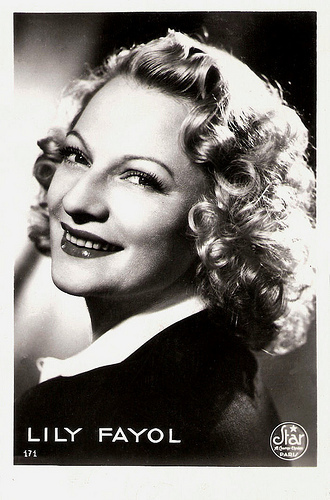
French postcard by Editions P.I., Paris, no. 171. Photo: Star, Paris.
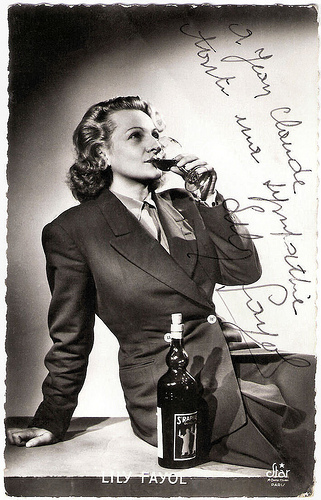
French postcard by Studio Star, Paris.
Queen for Six Days
In 1950, Lili Fayol was the star at the Theâtre du Châtelet in the operetta Annie du Far West (Wild West Annie) opposite Marcel Merkes.
She also appeared in such films as La Tournée des Grands-Ducs/The Tour Grand Dukes (André Pellenc, 1953) starring Raymond Bussières.
Married to the cycling champion Maurice Roux, she was the Reine des six jours (Queen for Six Days) at the Vélodrome d'hiver (Winter Velodrome). She retired and worked for years in the hotel business.
In 1977, she made a cinema come-back with the film La nuit, tous les chats sont gris/At Night All Cats Are Gray (Gérard Zingg, 1977) starring Gérard Depardieu .
Other films followed like the political comedy La Gueule de l'autre/The Other One's Mug (Pierre Tchernia, 1979) and the action comedy Le Guignolo/The Guignolo (Georges Lautner, 1980) starring Jean-Paul Belmondo .
Fayol also appeared several times on television, such as in the TV film Un beau petit milliard/A beautiful small billion (Pierre Tchernia, 1992) with Michel Galabru. Lili Fayol died in St. Raphaël, France, in 1999.
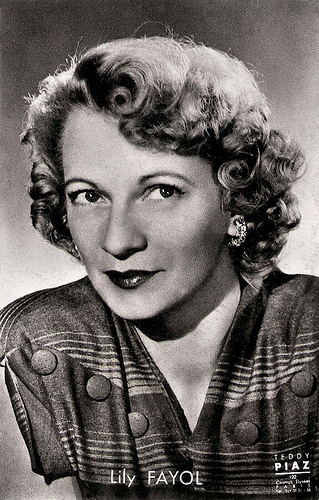
French card. Photo: Teddy Piaz, Paris.
Sources: AlloCiné (French), Wikipedia (French), and .

French postcard by Editions P.I., Paris, no. 72. Offered by S.A. Victoria, Bruxelles (Brussels). Photo: Star, Paris.
The American Rythm
Lily Fayol was born in Allevard, France, in 1914. She started her artistic career shortly before World War II.
In the 1940s she had her biggest successes with songs like Fifine, Les trois bandits de Napoli (The Three Bandits of Naples), and (Qui c'est qui fait glou-glou, c'est) La bouteille ((Who is making that gurgling sound, it is) The Bottle).
After the war, she had a huge hit with Le Rythme Américain (The American Rythm) in 1945. Her other popular songs included La guitare à Chiquita (Chiquita’s Guitar), and Le gros Bill (Big Bill).
In 1946, she made her film debut with a small part in Monsieur Grégoire s'évade/Mr. Gregoire Runs Away (Jacques Daniel-Norman, 1946) featuring Bernard Blier .
Three years later she starred opposite Tino Rossi in Marlène (Pierre de Hérain, 1949).

French postcard by Editions P.I., Paris, no. 171. Photo: Star, Paris.

French postcard by Studio Star, Paris.
Queen for Six Days
In 1950, Lili Fayol was the star at the Theâtre du Châtelet in the operetta Annie du Far West (Wild West Annie) opposite Marcel Merkes.
She also appeared in such films as La Tournée des Grands-Ducs/The Tour Grand Dukes (André Pellenc, 1953) starring Raymond Bussières.
Married to the cycling champion Maurice Roux, she was the Reine des six jours (Queen for Six Days) at the Vélodrome d'hiver (Winter Velodrome). She retired and worked for years in the hotel business.
In 1977, she made a cinema come-back with the film La nuit, tous les chats sont gris/At Night All Cats Are Gray (Gérard Zingg, 1977) starring Gérard Depardieu .
Other films followed like the political comedy La Gueule de l'autre/The Other One's Mug (Pierre Tchernia, 1979) and the action comedy Le Guignolo/The Guignolo (Georges Lautner, 1980) starring Jean-Paul Belmondo .
Fayol also appeared several times on television, such as in the TV film Un beau petit milliard/A beautiful small billion (Pierre Tchernia, 1992) with Michel Galabru. Lili Fayol died in St. Raphaël, France, in 1999.

French card. Photo: Teddy Piaz, Paris.
Sources: AlloCiné (French), Wikipedia (French), and .
Published on October 26, 2014 00:00
October 24, 2014
La seconda moglie (1922)
Today a special post on the Italian silent film La seconda moglie/The second wife (Amleto Palermi, 1922), based on the melodrama The Second Mrs. Tanqueray. Star is the fascinating and enigmatic Pina Menichelli, the most bizarre Italian diva of the silent era. Her leading man is Livio Pavanelli.
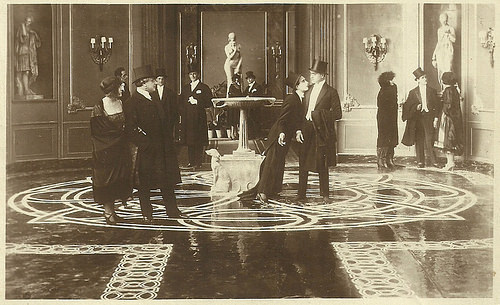
Italian postcard. Photo: Rinascimento Film, Roma. Caption: "Sir George starts to doubt the stability of the Primrose Restaurant." Postcard for the Italian silent film La seconda moglie (Amleto Palermi, 1922) with Alfredo Martinelli.
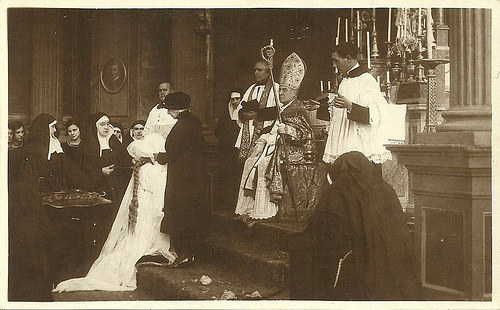
Italian postcard. Photo: Rinascimento Film, Roma. Caption: "The idea of becoming nun gives a shiver to Eliana's soul." Postcard for the Italian silent film La seconda moglie (Amleto Palermi, 1922) with Orietta Claudi.
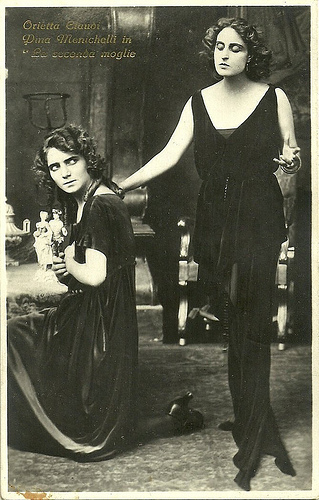
Italian postcard by G.B. Falci, Milano. Photo: Fotominio 78. Postcard with Orietta Claudi and Pina Menichelli in La seconda moglie (Amleto Palermi, 1922).
A mundane beauty
Lord Aubrey Tanqueray ( Livio Pavanelli ) loses his wife, a woman of rigid habits who had managed to perfectly organize his life up to his station, but she has left him sentimentally unsatisfied. Left alone, Tanqueray sends his daughter to a religious college and leads a grey and recluse life.
Years go by. The man gets tired of his solitude and starts to frequent the London society. He meets Paula ( Pina Menichelli ), a mundane beauty, falls in love with her and marries her.
Though the woman has decided to abandon her once so liberal life and shows she's eager to convert, she doesn't manage to bond with Eliana (Orietta Claudi), now a girl in full blossom, who despises of the intruder.
In an attempt to solve the situation, Tanqueray decides to send the girl to Paris. Here Elina meets captain Ardale (Alfredo Menichelli), falls in love with him, and returned, home, presents him as her fiancé. But Paula recognizes in Ardale one of her ex-lovers. She confesses to Eliana her guilt in deterring the girl to unite her life with an adventurer and makes an end to her life by a gun shot.
The play from which the film was adapted, The Second Mrs. Tanqueray by Arthur Wing Pinero, had already been the vehicle for stage actresses such as Eleonora Duse , Virigina Reiter and Italia Vitaliani , and afterwards Maria Melato and Emma Grammatica.
Though the film, released in 1923, was received with mixed reviews, it was one of Pina Menichelli 's most popular films, both in Italy and abroad.
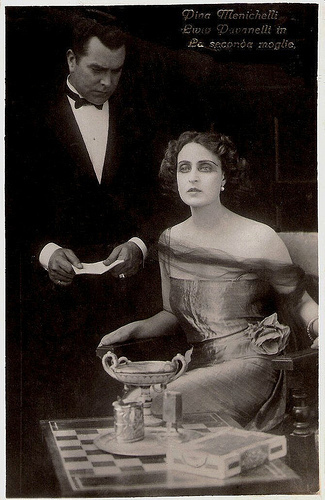
Italian postcard by G.B. Falci, Milano. Photo: Fotominio 78. Postcard with Pina Menichelli in La seconda moglie (Amleto Palermi, 1922).
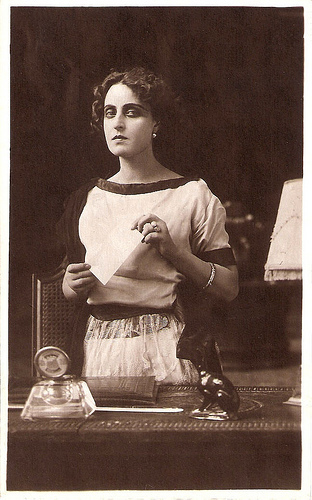
Italian postcard. Photo: Rinascimento Film, Roma. Caption: "That monotonous and grey life awoke in the rebel a whole lost world." Postcard for the Italian silent film La seconda moglie (Amleto Palermi, 1922) with Pina Menichelli.
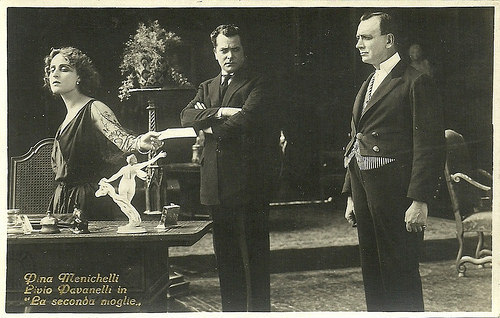
Italian postcard by G.B. Falci, Milano. Postcard for the Italian silent film La seconda moglie (Amleto Palermi, 1922) with Pina Menichelli and Livio Pavanelli.
Orietta Claudi
Orietta Claudi (?-?), who played Eliana, had a relatively short career in Italian silent cinema of the early 1920s. She mostly played the young family girl opposite the mundane divas such as Pina Menichelli , Italia Almirante Manzini and Maria Jacobini .
She probably debuted in L'Innamorata (Gennaro Righelli, 1920), starring Almirante Manzini. Claudi's character had her real first name Orietta (or was Orietta not the real name of Claudi?).
After Stelle (Riccardo Cassano, 1920) and Il supplizio del silenzio (Eugenio Perego, 1920), Claudi acted opposite Maria Jacobini and Amleto Novelli in La casa di vetro (Gennaro Righelli, 1920).
In the very successful drama Amore rosso (Gennaro Righelli, 1921), Claudi played the rival of Jacobini in winning the love of Lido Manetti .
After Il cielo (André Habay, 1921) starring director Habay as a pilot who risks getting blind and Claudi as his British fiancée, she acted as the hostile daughter Eliana opposite Pina Menichelli and Livio Pavanelli in La seconda moglie (Amleto Palermi, 1922).
Claudi's last parts were in Il sogno d'amore (Gennaro Righelli, 1922) with Almirante Manzini, and La gerla di papà Martin (Mario Bonnard, 1923) with Gianna Terribili Gonzales.
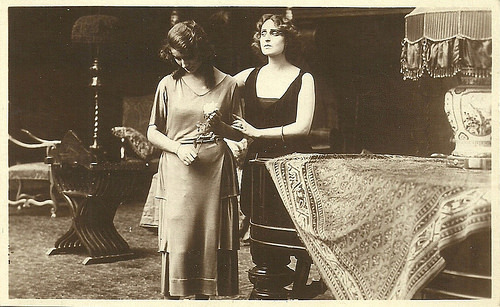
Italian postcard. Caption: "Paola: No! Forgive me... We will really be good friends..." Postcard for the Italian silent film La seconda moglie (Amleto Palermi, 1922) with Pina Menichelli and Orietta Claudi.
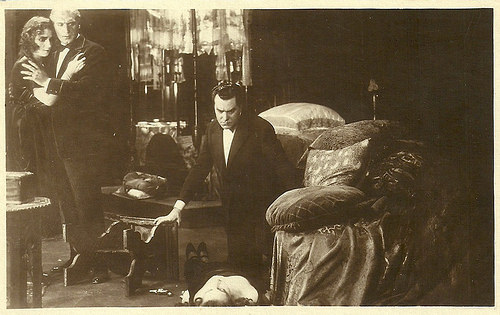
Italian postcard. Photo: Rinascimento Film, Roma. Caption: "Eliana: Oh, had I only been nicer to her!" Postcard for the Italian silent film La seconda moglie/The second wife (Amleto Palermi, 1922) with Pina Menichelli, Livio Pavanelli and Orietta Claudi.
Sources: Vittorio Martinelli (Italian - Il cinema muto italiano, 1921-1922) and IMDb.

Italian postcard. Photo: Rinascimento Film, Roma. Caption: "Sir George starts to doubt the stability of the Primrose Restaurant." Postcard for the Italian silent film La seconda moglie (Amleto Palermi, 1922) with Alfredo Martinelli.

Italian postcard. Photo: Rinascimento Film, Roma. Caption: "The idea of becoming nun gives a shiver to Eliana's soul." Postcard for the Italian silent film La seconda moglie (Amleto Palermi, 1922) with Orietta Claudi.

Italian postcard by G.B. Falci, Milano. Photo: Fotominio 78. Postcard with Orietta Claudi and Pina Menichelli in La seconda moglie (Amleto Palermi, 1922).
A mundane beauty
Lord Aubrey Tanqueray ( Livio Pavanelli ) loses his wife, a woman of rigid habits who had managed to perfectly organize his life up to his station, but she has left him sentimentally unsatisfied. Left alone, Tanqueray sends his daughter to a religious college and leads a grey and recluse life.
Years go by. The man gets tired of his solitude and starts to frequent the London society. He meets Paula ( Pina Menichelli ), a mundane beauty, falls in love with her and marries her.
Though the woman has decided to abandon her once so liberal life and shows she's eager to convert, she doesn't manage to bond with Eliana (Orietta Claudi), now a girl in full blossom, who despises of the intruder.
In an attempt to solve the situation, Tanqueray decides to send the girl to Paris. Here Elina meets captain Ardale (Alfredo Menichelli), falls in love with him, and returned, home, presents him as her fiancé. But Paula recognizes in Ardale one of her ex-lovers. She confesses to Eliana her guilt in deterring the girl to unite her life with an adventurer and makes an end to her life by a gun shot.
The play from which the film was adapted, The Second Mrs. Tanqueray by Arthur Wing Pinero, had already been the vehicle for stage actresses such as Eleonora Duse , Virigina Reiter and Italia Vitaliani , and afterwards Maria Melato and Emma Grammatica.
Though the film, released in 1923, was received with mixed reviews, it was one of Pina Menichelli 's most popular films, both in Italy and abroad.

Italian postcard by G.B. Falci, Milano. Photo: Fotominio 78. Postcard with Pina Menichelli in La seconda moglie (Amleto Palermi, 1922).

Italian postcard. Photo: Rinascimento Film, Roma. Caption: "That monotonous and grey life awoke in the rebel a whole lost world." Postcard for the Italian silent film La seconda moglie (Amleto Palermi, 1922) with Pina Menichelli.

Italian postcard by G.B. Falci, Milano. Postcard for the Italian silent film La seconda moglie (Amleto Palermi, 1922) with Pina Menichelli and Livio Pavanelli.
Orietta Claudi
Orietta Claudi (?-?), who played Eliana, had a relatively short career in Italian silent cinema of the early 1920s. She mostly played the young family girl opposite the mundane divas such as Pina Menichelli , Italia Almirante Manzini and Maria Jacobini .
She probably debuted in L'Innamorata (Gennaro Righelli, 1920), starring Almirante Manzini. Claudi's character had her real first name Orietta (or was Orietta not the real name of Claudi?).
After Stelle (Riccardo Cassano, 1920) and Il supplizio del silenzio (Eugenio Perego, 1920), Claudi acted opposite Maria Jacobini and Amleto Novelli in La casa di vetro (Gennaro Righelli, 1920).
In the very successful drama Amore rosso (Gennaro Righelli, 1921), Claudi played the rival of Jacobini in winning the love of Lido Manetti .
After Il cielo (André Habay, 1921) starring director Habay as a pilot who risks getting blind and Claudi as his British fiancée, she acted as the hostile daughter Eliana opposite Pina Menichelli and Livio Pavanelli in La seconda moglie (Amleto Palermi, 1922).
Claudi's last parts were in Il sogno d'amore (Gennaro Righelli, 1922) with Almirante Manzini, and La gerla di papà Martin (Mario Bonnard, 1923) with Gianna Terribili Gonzales.

Italian postcard. Caption: "Paola: No! Forgive me... We will really be good friends..." Postcard for the Italian silent film La seconda moglie (Amleto Palermi, 1922) with Pina Menichelli and Orietta Claudi.

Italian postcard. Photo: Rinascimento Film, Roma. Caption: "Eliana: Oh, had I only been nicer to her!" Postcard for the Italian silent film La seconda moglie/The second wife (Amleto Palermi, 1922) with Pina Menichelli, Livio Pavanelli and Orietta Claudi.
Sources: Vittorio Martinelli (Italian - Il cinema muto italiano, 1921-1922) and IMDb.
Published on October 24, 2014 22:00
October 23, 2014
Elisabeth Pinajeff
Russian-Lithuanian actress Elisabeth Pinajeff (1900-1995) starred in 33 German and French films in the 1920's and 1930's. She was married to famous photographer Alex Binder. In the 1950's she was involved in a notorious scandal involving erotic ballets with underaged girls, the 'Ballets roses' scandal.
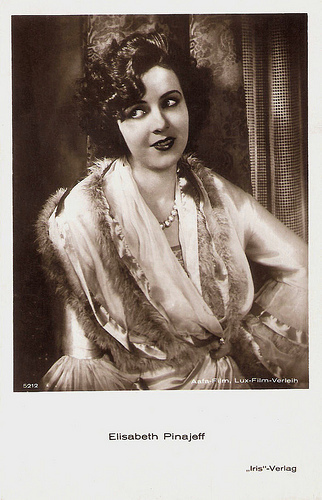
Austrian postcard by Iris-Verlag, no. 5212. Photo: Aafa-Film / Lux-Film-Verleih.
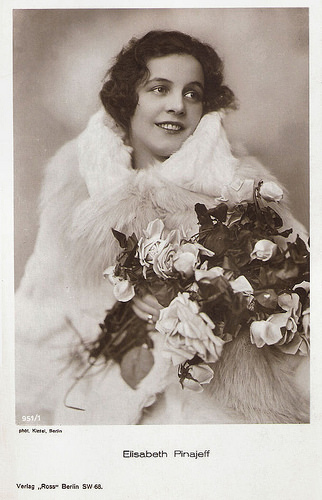
German postcard by Ross Verlag, no. 951/1, 1925-1926. Photo: Kiesel, Berlin.
Real Russian Actors
About the birth of Elisabeth Pinajeff or Elisabeth Pinajewa, our sources state different dates and locations. While Philippe Pellettier at the French website Ciné-Artistes indicates that she was born 4 April 1900 in Wilna (Vilnius), then part of the Russian Empire and now Lithuania, his German colleague Thomas Staedeli of the Cyranos website writes instead that she was born 17 April 1900 in Jekaterinoslaw, now Dnipropetrowsk in Ukraine. (She probably was born in Vilnius, and grew up in Dnipropetrowsk).
However, Pinajeff was the daughter of architect Serge Pinajeff and countess Anna Popov. In the 1910s she did her studies in Kharkiv (Charkow), in Ukraine, and attended dramatic classes too.
She supposedly played in two silent Russian films, but which ones is unknown. At age 19 she married an engineer. When her husband got a job in Germany, she moved there with him.
Her film career chance came in 1921, when Danish director Carl Theodor Dreyer advertised in a newspaper that he was looking for authentic Russians to play in his first German film Die Gezeichneten/Love One Another (Carl Theodor Dreyer, 1921). Elisabeth Pinajeff got a small part in the film and not the female lead, as Philippe Pellettier writes. The leading lady was countess Polina Piechovska, while the male lead was played by Vladimir Gajdarov .
Subsequently, Pinajeff contributed to many silent German films, often as a classy seductress. She already had the second female lead in one of her next German films, Königsliebchen/Darling of the King (Heinz Schall, 1924), opposite Ruth Weyher and Bruno Kastner .
In the mid-1920s Elisabeth Pinajeff often was the second actress after the female star, and so she was destined to play the rival, as in Die Brigantin von New York (Hans Werckmeister, 1924) with Lotte Neumann , and in Herrn Philip Collins Abenteuer/Mr Philip Collins Adventure (Johannes Guter, 1925) with Georg Alexander and Ossi Oswalda .
In 1926 she had the female lead in the aristocratic drama Spitze'/Have an eye (Holger-Madsen, 1926) opposite Olaf Fönss . She played the dancer Beatrice opposite Luciano Albertini in the adventure film Rinaldo Rinaldini (Max Obal, 1926-1927).
Pinajeff co-starred with Alphons Fryland in Gern habe ich die Frauen gekusst/Gladly I have kissed the women (Bruno Rahn, 1926), and she was one of the three models in Die drei Mannequins/The Three Mannequins (Jaap Speyer, 1926).
Next, she played opposite Maly Delschaft in Die Kleine und ihr Kavalier/The Little One and her Gentleman (Richard Lowenstein, 1926), opposite Livio Pavanelli and Hans Albers in Die lachende Ehemann/The laughing husband (Rudolf Walther-Fein, 1926), with Xenia Desni in Ein rheinisches Mädchen beim rheinischen Wein/An Honest Girl with an Honest Wine (Johannes Guter, 1927), and with Liane Haid in Die Dollarprinzessin und ihre sechs Freier/The Dollar Princess and Her Six Lovers (Felix Basch, 1927).
In the late 1920s, Pinajeff starred in the Austrian productions Wem gehört meine Frau/To Whom Belongs My Wife (Hans Otto Lowenstein, 1928) and Mitternachtswalzer/Midnight Waltz (Heinz Paul, 1928), both with André Mattoni , and in the Anglo-German-Hungarian co-production Der fesche Husar (Geza von Bolvary, 1928) with Evelyn Holt .
Pinajeff’s last silent film was Mutterliebe (Georg Jacoby, 1929), starring Henny Porten and Gustav Diessl .
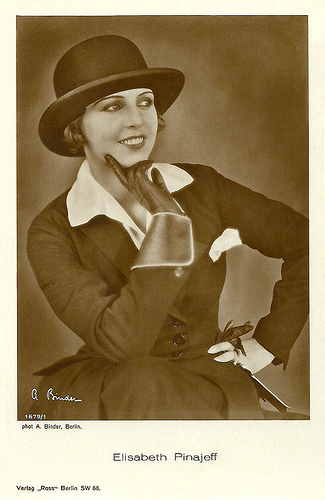
German postcard by Ross Verlag, no. 1679/1, 1927-1928. Photo: Alex Binder, Berlin.
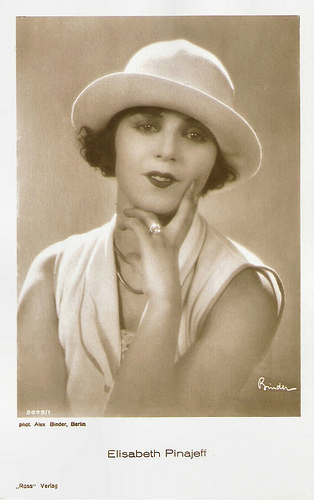
German postcard by Ross Verlag, no. 2075/1, 1927-1928. Photo: Alex Binder, Berlin.
Alex Binder
Elisabeth Pinajeff's first part in a sound film was in Ruhiges Heim mit Küchenbenützung/Das Mädel der Filmoperette (Carl Wilhelm, 1929). This was not a large part, but in her following sound film Tingel-Tangel (Jaap Speyer, 1930), Pinajeff had the female lead opposite Ernö Verebes .
Her other German sound films were Schatten der Unterwelt/Shadows of the Underworld ( Harry Piel , 1931), Die Vier vom Bob 13/The Four of the Bob 13 (Johannes Guter, 1932), and Madame hat Ausgang/Madame has exit (Wilhelm Thiele, 1931), starring Liane Haid .
All three films were multi-linguals and were shot in French versions too, and Pinajeff played in all the French versions as well. Madame hat Ausgang became L’amoureuse aventure (Wilhelm Thiele, 1931) starring Marie Glory and Albert Préjean .
Schatten der Unterwelt became Ombres des bas fonds ( Harry Piel , 1931). Die Vier vom Bob 13 became L’amour en vitesse (Johannes Guter, Claude Heymann 1932) and starred Dolly Davis .
According to Ciné-Artistes and other sources, Pinajeff had met Austrian photographer Alex Binder in 1929. Binder had the biggest photo studio in Europe in the 1920s and by 1929 he lived in Paris. Pinajeff became first his model, then his wife. Problematic with this information, however, is that the postcard above with a picture by Binder was already produced in 1927-1928 and that Binder died in February 1929 in Berlin. So of this info is right, they must have met earlier.
Under the name of Lily Dorell, Pinajeff played a small part as Dolly Croquette in Vacances conjugales/Conjugal holidays (Edmond Gréville, 1933) and a substantial part in Le triangle de feu/The Triangle of Fire (Edmond Gréville, Johannes Guter, 1933).
After some years of ’radio silence’, Pinajeff had a last bit part in La tragédie impériale/Rasputin (Marcel L’Herbier, 1937), a film about Siberian monk Gregory Rasputin ( Harry Baur ) and the hold he exerted over the court of the last Russian czar, Nicholas. Then Pinajeff retired from the film business and dedicated herself to painting.
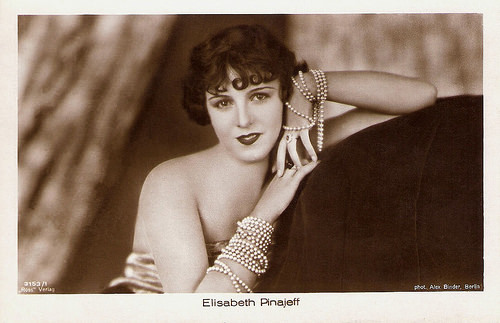
German postcard by Ross Verlag, no. 3153/1, 1928-1929. Photo: Alex Binder, Berlin.
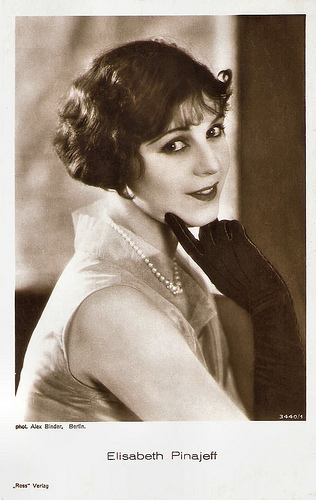
German postcard by Ross Verlag, no. 3440/1, 1928-1929. Photo: Alex Binder, Berlin.
Ballets Roses scandal
Elisabeth Pinajeff's star rose within the Parisian mundane circles and thus she seems to have had an easy time during the war years.
In 1950 she became the lady friend of André Le Troquer, a high placed lawyer and politician. He had been a war hero in 1914-1918 and had lost an arm there. He had also been the defender of Léon Blum during 'Vichy’ and he was Chair of the National Assembly in 1954-1955 and 1956-1958.
The couple surrounded themselves by everyone who counted in political, artistic and intellectual circles. Thanks to her connections, Pinajeff painted famous personalities such as the British Queen and the wife of president Coty. She exhibited her paintings with some success at the Salon des femmes peintres et sculpteurs(the salon for female painters und sculptors) as well as at the Galerie André Weill in Paris.
Then in January 1959 a huge scandal exploded. Le Troquer, Pinajeff and some twenty other persons were involved in the so-called 'Ballets Roses scandal'. Pinajeff supposedly had organised erotic ballets with under aged girls for an elite audience. Some of the mothers of the girls had consented to this, hoping for career perspectives for their children.
The couple got away with it quite mildly because of Le Troquer’s high age and his war record, but both their careers were over. Rumour has it that the whole affair was concocted by the Gaulists to discredit the socialist Le Troquer.
Elisabeth Pinajeff withdrew to a small house in Villemoison-sur-Orge, near Paris. There she died in 1995, virtually forgotten.
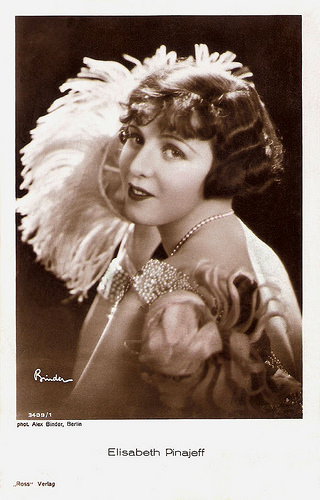
German postcard by Ross Verlag, no. 3409/1, 1928-1929. Photo: Alex Binder, Berlin.
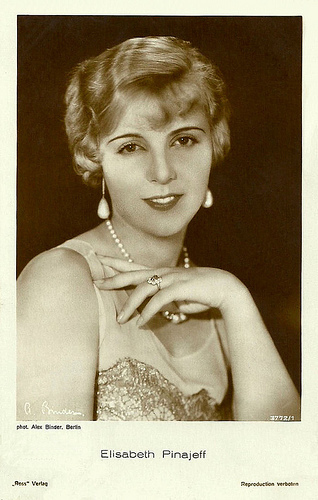
German postcard by Ross Verlag, no. 3772/1, 1928-1929. Photo: Alex Binder.
Sources: Thomas Staedeli (Cyranos), Philippe Pellettier (Ciné-Artistes), Wikipedia, Wikipedia (French), , and ,

Austrian postcard by Iris-Verlag, no. 5212. Photo: Aafa-Film / Lux-Film-Verleih.

German postcard by Ross Verlag, no. 951/1, 1925-1926. Photo: Kiesel, Berlin.
Real Russian Actors
About the birth of Elisabeth Pinajeff or Elisabeth Pinajewa, our sources state different dates and locations. While Philippe Pellettier at the French website Ciné-Artistes indicates that she was born 4 April 1900 in Wilna (Vilnius), then part of the Russian Empire and now Lithuania, his German colleague Thomas Staedeli of the Cyranos website writes instead that she was born 17 April 1900 in Jekaterinoslaw, now Dnipropetrowsk in Ukraine. (She probably was born in Vilnius, and grew up in Dnipropetrowsk).
However, Pinajeff was the daughter of architect Serge Pinajeff and countess Anna Popov. In the 1910s she did her studies in Kharkiv (Charkow), in Ukraine, and attended dramatic classes too.
She supposedly played in two silent Russian films, but which ones is unknown. At age 19 she married an engineer. When her husband got a job in Germany, she moved there with him.
Her film career chance came in 1921, when Danish director Carl Theodor Dreyer advertised in a newspaper that he was looking for authentic Russians to play in his first German film Die Gezeichneten/Love One Another (Carl Theodor Dreyer, 1921). Elisabeth Pinajeff got a small part in the film and not the female lead, as Philippe Pellettier writes. The leading lady was countess Polina Piechovska, while the male lead was played by Vladimir Gajdarov .
Subsequently, Pinajeff contributed to many silent German films, often as a classy seductress. She already had the second female lead in one of her next German films, Königsliebchen/Darling of the King (Heinz Schall, 1924), opposite Ruth Weyher and Bruno Kastner .
In the mid-1920s Elisabeth Pinajeff often was the second actress after the female star, and so she was destined to play the rival, as in Die Brigantin von New York (Hans Werckmeister, 1924) with Lotte Neumann , and in Herrn Philip Collins Abenteuer/Mr Philip Collins Adventure (Johannes Guter, 1925) with Georg Alexander and Ossi Oswalda .
In 1926 she had the female lead in the aristocratic drama Spitze'/Have an eye (Holger-Madsen, 1926) opposite Olaf Fönss . She played the dancer Beatrice opposite Luciano Albertini in the adventure film Rinaldo Rinaldini (Max Obal, 1926-1927).
Pinajeff co-starred with Alphons Fryland in Gern habe ich die Frauen gekusst/Gladly I have kissed the women (Bruno Rahn, 1926), and she was one of the three models in Die drei Mannequins/The Three Mannequins (Jaap Speyer, 1926).
Next, she played opposite Maly Delschaft in Die Kleine und ihr Kavalier/The Little One and her Gentleman (Richard Lowenstein, 1926), opposite Livio Pavanelli and Hans Albers in Die lachende Ehemann/The laughing husband (Rudolf Walther-Fein, 1926), with Xenia Desni in Ein rheinisches Mädchen beim rheinischen Wein/An Honest Girl with an Honest Wine (Johannes Guter, 1927), and with Liane Haid in Die Dollarprinzessin und ihre sechs Freier/The Dollar Princess and Her Six Lovers (Felix Basch, 1927).
In the late 1920s, Pinajeff starred in the Austrian productions Wem gehört meine Frau/To Whom Belongs My Wife (Hans Otto Lowenstein, 1928) and Mitternachtswalzer/Midnight Waltz (Heinz Paul, 1928), both with André Mattoni , and in the Anglo-German-Hungarian co-production Der fesche Husar (Geza von Bolvary, 1928) with Evelyn Holt .
Pinajeff’s last silent film was Mutterliebe (Georg Jacoby, 1929), starring Henny Porten and Gustav Diessl .

German postcard by Ross Verlag, no. 1679/1, 1927-1928. Photo: Alex Binder, Berlin.

German postcard by Ross Verlag, no. 2075/1, 1927-1928. Photo: Alex Binder, Berlin.
Alex Binder
Elisabeth Pinajeff's first part in a sound film was in Ruhiges Heim mit Küchenbenützung/Das Mädel der Filmoperette (Carl Wilhelm, 1929). This was not a large part, but in her following sound film Tingel-Tangel (Jaap Speyer, 1930), Pinajeff had the female lead opposite Ernö Verebes .
Her other German sound films were Schatten der Unterwelt/Shadows of the Underworld ( Harry Piel , 1931), Die Vier vom Bob 13/The Four of the Bob 13 (Johannes Guter, 1932), and Madame hat Ausgang/Madame has exit (Wilhelm Thiele, 1931), starring Liane Haid .
All three films were multi-linguals and were shot in French versions too, and Pinajeff played in all the French versions as well. Madame hat Ausgang became L’amoureuse aventure (Wilhelm Thiele, 1931) starring Marie Glory and Albert Préjean .
Schatten der Unterwelt became Ombres des bas fonds ( Harry Piel , 1931). Die Vier vom Bob 13 became L’amour en vitesse (Johannes Guter, Claude Heymann 1932) and starred Dolly Davis .
According to Ciné-Artistes and other sources, Pinajeff had met Austrian photographer Alex Binder in 1929. Binder had the biggest photo studio in Europe in the 1920s and by 1929 he lived in Paris. Pinajeff became first his model, then his wife. Problematic with this information, however, is that the postcard above with a picture by Binder was already produced in 1927-1928 and that Binder died in February 1929 in Berlin. So of this info is right, they must have met earlier.
Under the name of Lily Dorell, Pinajeff played a small part as Dolly Croquette in Vacances conjugales/Conjugal holidays (Edmond Gréville, 1933) and a substantial part in Le triangle de feu/The Triangle of Fire (Edmond Gréville, Johannes Guter, 1933).
After some years of ’radio silence’, Pinajeff had a last bit part in La tragédie impériale/Rasputin (Marcel L’Herbier, 1937), a film about Siberian monk Gregory Rasputin ( Harry Baur ) and the hold he exerted over the court of the last Russian czar, Nicholas. Then Pinajeff retired from the film business and dedicated herself to painting.

German postcard by Ross Verlag, no. 3153/1, 1928-1929. Photo: Alex Binder, Berlin.

German postcard by Ross Verlag, no. 3440/1, 1928-1929. Photo: Alex Binder, Berlin.
Ballets Roses scandal
Elisabeth Pinajeff's star rose within the Parisian mundane circles and thus she seems to have had an easy time during the war years.
In 1950 she became the lady friend of André Le Troquer, a high placed lawyer and politician. He had been a war hero in 1914-1918 and had lost an arm there. He had also been the defender of Léon Blum during 'Vichy’ and he was Chair of the National Assembly in 1954-1955 and 1956-1958.
The couple surrounded themselves by everyone who counted in political, artistic and intellectual circles. Thanks to her connections, Pinajeff painted famous personalities such as the British Queen and the wife of president Coty. She exhibited her paintings with some success at the Salon des femmes peintres et sculpteurs(the salon for female painters und sculptors) as well as at the Galerie André Weill in Paris.
Then in January 1959 a huge scandal exploded. Le Troquer, Pinajeff and some twenty other persons were involved in the so-called 'Ballets Roses scandal'. Pinajeff supposedly had organised erotic ballets with under aged girls for an elite audience. Some of the mothers of the girls had consented to this, hoping for career perspectives for their children.
The couple got away with it quite mildly because of Le Troquer’s high age and his war record, but both their careers were over. Rumour has it that the whole affair was concocted by the Gaulists to discredit the socialist Le Troquer.
Elisabeth Pinajeff withdrew to a small house in Villemoison-sur-Orge, near Paris. There she died in 1995, virtually forgotten.

German postcard by Ross Verlag, no. 3409/1, 1928-1929. Photo: Alex Binder, Berlin.

German postcard by Ross Verlag, no. 3772/1, 1928-1929. Photo: Alex Binder.
Sources: Thomas Staedeli (Cyranos), Philippe Pellettier (Ciné-Artistes), Wikipedia, Wikipedia (French), , and ,
Published on October 23, 2014 23:00
October 22, 2014
Ruth Leuwerik
German box office queen Ruth Leuwerik (1924) played Maria in the original version of The Sound of Music, Die Trapp-Familie (1956). In the 1950s, she and co-star O.W. Fischer were Germany's favourite couple.
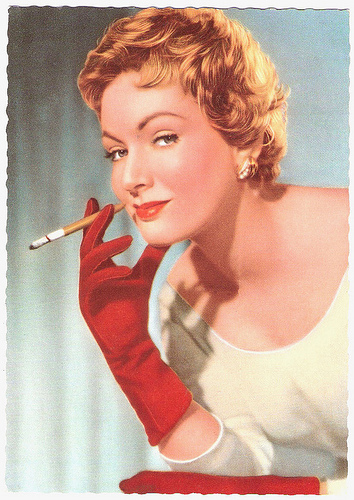
German postcard by Universum-Film Aktiengesellschaft, Berlin-Tempelhof (Ufa), no. CK 117. Retail price: 30 Pfg. Photo: Arthur Grimm.
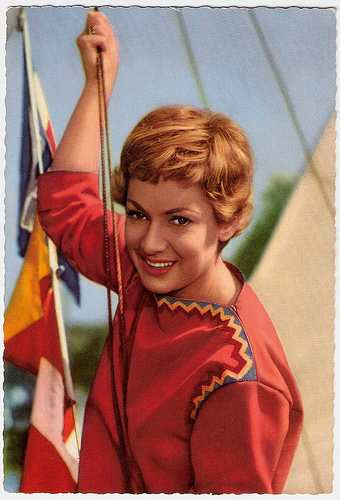
Belgian postcard by Edition H. Troukens, Hofstade. Photo: Ufa.
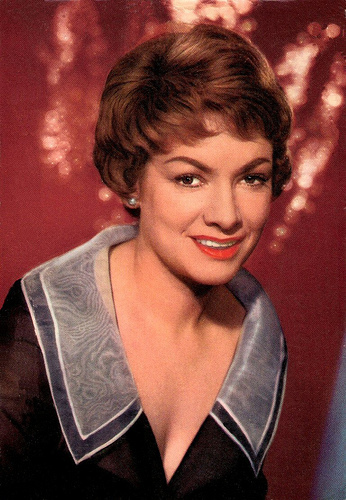
German postcard printed by ISV, no. H 49.
Dieter Borsche
Ruth Leuwerik was born in Essen, Germany, in 1924. She made her stage debut during the war with the touring company of the Landestheaters Münster.
Her film career started with a supporting role in 13 unter einem Hut/13 Under a Hat (Johannes Meyer, 1950), but the film was not a hit.
When she was introduced to film actor Dieter Borsche , he made her his leading lady in Vater braucht eine Frau/Father Needs A Woman (Harald Braun, 1952).
The comedy became a surprise hit and the two leads immediately made another box office smash, Die große Versuchung/The Big Temptation (Rolf Hansen, 1952).
In 1953 she had her definitive breakthrough with four films. In the romantic melodrama Ein Herz spielt falsch/A Heart's Foul Play (Rudolf Jugert, 1953) she played for the first time with O.W. Fischer . They became the beloved Traumpaar (Dream couple) of the German public.
In Königliche Hoheit/His Royal Highness (Harald Braun, 1953) she was an American heiress raised in Europe, who falls in love with a handsome but shy German prince ( Dieter Borsche ). The story was adapted from a novel by Thomas Mann, who was pleased with the film version.
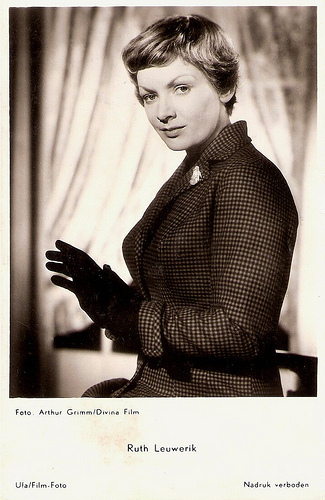
Dutch postcard by Gebr. Spanjersberg N.V., Rotterdam, no. 3331. Photo: Ufa/Film-Foto / Arthur Grimm / Divina Film.
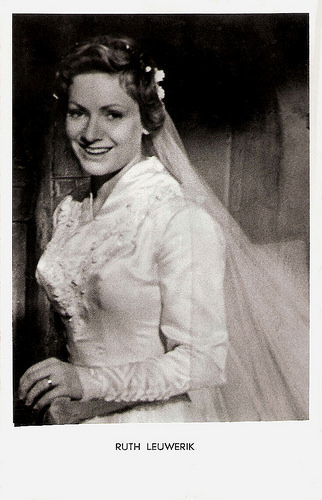
Dutch postcard, no. 63.
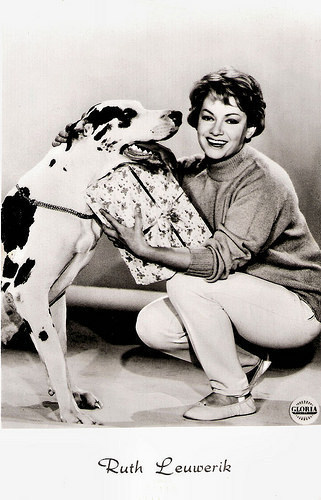
Dutch postcard, no. 5942. Photo: Gloria.
Independent
Ruth Leuwerik played in many costume pictures, including Ludwig II/Mad Emperor: Ludwig II (Helmut Käutner, 1955) as Elisabeth of Austria with O.W. Fischer as her nephew Ludwig II, and Rosen im Herbst/Roses in the Autumn (Rudolf Jugert, 1955), based on Theodor Fontane’s Effi Briest. It seemed to become her trademark.
Her career was revitalized with Die Trapp-Familie/The Trapp Family ( Wolfgang Liebeneiner , 1956) and the sequel Die Trapp-Familie in Amerika/The Trapp Family in America (Wolfgang Liebeneiner, 1958) about the free spirited nun and nanny Maria who becomes Baroness Von Trapp.
At IMDb, Maurice de Saxe writes about Die Trapp-Familie: "Largely forgotten today, the pic holds up quite well. The story is not too exciting, there's nothing that might offend blue-noses and all takes place against an pastoral background of green meadows and snow-capped mountains. Ruth Leuwerik does what she can with the wafer-thin part and her warmth and natural beauty prevent the whole thing form being too syrupy."
Together with the box office success of the war camp drama Taiga (Wolfgang Liebeneiner, 1958) these films made her the most popular German film star of the late 1950s. She was beloved by female filmgoers, because of her independent, professionally successful characters.
In the 1960s her film popularity waned. The well-intended but somewhat muddled Die Rote/Redhead (Helmut Käutner, 1962) sealed her fate as box-office cyanide after a string of flops. But according to reviewer Jan de Witt at IMDb her performance in this film is "very subtle, giving the over-complicated story its little coherence."
After this film she started to work mainly for TV, including guest appearances in the Krimi series Derrick (1978-1983). Her last film was Unordnung und Fruehes Leid/Disorder And Early Torment (Frans Seitz, 1977) with Martin Held.
Among her many awards are the Filmband in Gold in 1974 and the Großen Verdienstkreuz der Bundesrepublik Deutschland (Germany's Cross of merit) in 1980.
Nowadays Ruth Leuwerik lives in retirement in Munich with her third husband, Dr. Heinz Purper. She was also married to actor Herbert Fleischmann and singer-conductor Dietrich Fischer-Dieskau.
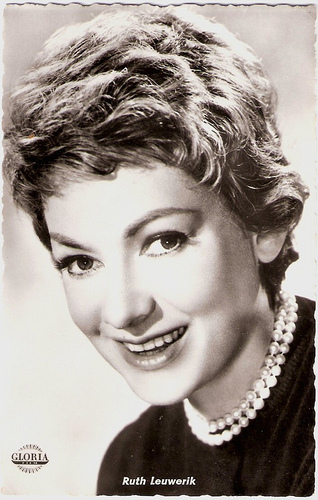
German postcard by Kolibri-Verlag G.m.b.H, Minden/Westf., no. 397. Photo: Weisse / Divina / Gloria.
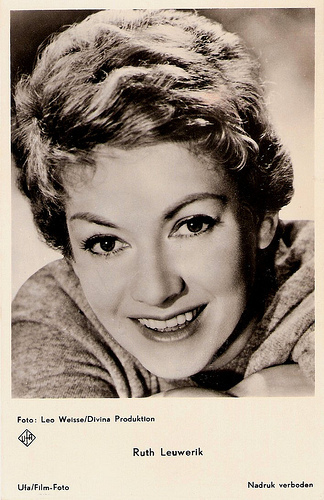
Dutch postcard by Gebr. Spanjersberg N.V., Rotterdam, no. 4262. Photo: Ufa/Film-Foto / Leo Weisse / Divina Film.
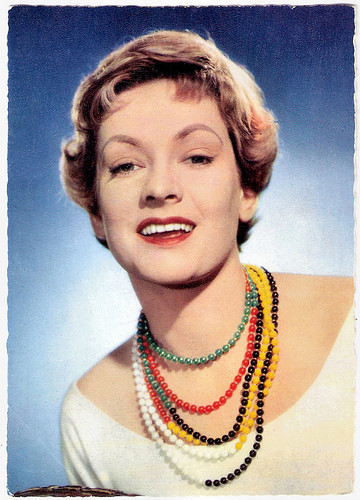
German postcard by Franz Josef Rüdel, Filmpostkartenverlag, Hamburg-Bergedorf, no. FT 33. Photo: CCC / Gloria / Grimm. Publicity still for Auf Wiedersehen, Franziska!/Goodbye, Franziska! (Wolfgang Liebeneiner, 1957).
Scene from Vater braucht eine Frau/Father Needs A Woman (1952). Source: Liebhaber Alter Filme (YouTube).
Sources: Stephanie D'heil (Steffi-line) (German), Maurice de Saxe (IMDb), Jan de Witt (IMDb), AllMovie, Wikipedia, and .

German postcard by Universum-Film Aktiengesellschaft, Berlin-Tempelhof (Ufa), no. CK 117. Retail price: 30 Pfg. Photo: Arthur Grimm.

Belgian postcard by Edition H. Troukens, Hofstade. Photo: Ufa.

German postcard printed by ISV, no. H 49.
Dieter Borsche
Ruth Leuwerik was born in Essen, Germany, in 1924. She made her stage debut during the war with the touring company of the Landestheaters Münster.
Her film career started with a supporting role in 13 unter einem Hut/13 Under a Hat (Johannes Meyer, 1950), but the film was not a hit.
When she was introduced to film actor Dieter Borsche , he made her his leading lady in Vater braucht eine Frau/Father Needs A Woman (Harald Braun, 1952).
The comedy became a surprise hit and the two leads immediately made another box office smash, Die große Versuchung/The Big Temptation (Rolf Hansen, 1952).
In 1953 she had her definitive breakthrough with four films. In the romantic melodrama Ein Herz spielt falsch/A Heart's Foul Play (Rudolf Jugert, 1953) she played for the first time with O.W. Fischer . They became the beloved Traumpaar (Dream couple) of the German public.
In Königliche Hoheit/His Royal Highness (Harald Braun, 1953) she was an American heiress raised in Europe, who falls in love with a handsome but shy German prince ( Dieter Borsche ). The story was adapted from a novel by Thomas Mann, who was pleased with the film version.

Dutch postcard by Gebr. Spanjersberg N.V., Rotterdam, no. 3331. Photo: Ufa/Film-Foto / Arthur Grimm / Divina Film.

Dutch postcard, no. 63.

Dutch postcard, no. 5942. Photo: Gloria.
Independent
Ruth Leuwerik played in many costume pictures, including Ludwig II/Mad Emperor: Ludwig II (Helmut Käutner, 1955) as Elisabeth of Austria with O.W. Fischer as her nephew Ludwig II, and Rosen im Herbst/Roses in the Autumn (Rudolf Jugert, 1955), based on Theodor Fontane’s Effi Briest. It seemed to become her trademark.
Her career was revitalized with Die Trapp-Familie/The Trapp Family ( Wolfgang Liebeneiner , 1956) and the sequel Die Trapp-Familie in Amerika/The Trapp Family in America (Wolfgang Liebeneiner, 1958) about the free spirited nun and nanny Maria who becomes Baroness Von Trapp.
At IMDb, Maurice de Saxe writes about Die Trapp-Familie: "Largely forgotten today, the pic holds up quite well. The story is not too exciting, there's nothing that might offend blue-noses and all takes place against an pastoral background of green meadows and snow-capped mountains. Ruth Leuwerik does what she can with the wafer-thin part and her warmth and natural beauty prevent the whole thing form being too syrupy."
Together with the box office success of the war camp drama Taiga (Wolfgang Liebeneiner, 1958) these films made her the most popular German film star of the late 1950s. She was beloved by female filmgoers, because of her independent, professionally successful characters.
In the 1960s her film popularity waned. The well-intended but somewhat muddled Die Rote/Redhead (Helmut Käutner, 1962) sealed her fate as box-office cyanide after a string of flops. But according to reviewer Jan de Witt at IMDb her performance in this film is "very subtle, giving the over-complicated story its little coherence."
After this film she started to work mainly for TV, including guest appearances in the Krimi series Derrick (1978-1983). Her last film was Unordnung und Fruehes Leid/Disorder And Early Torment (Frans Seitz, 1977) with Martin Held.
Among her many awards are the Filmband in Gold in 1974 and the Großen Verdienstkreuz der Bundesrepublik Deutschland (Germany's Cross of merit) in 1980.
Nowadays Ruth Leuwerik lives in retirement in Munich with her third husband, Dr. Heinz Purper. She was also married to actor Herbert Fleischmann and singer-conductor Dietrich Fischer-Dieskau.

German postcard by Kolibri-Verlag G.m.b.H, Minden/Westf., no. 397. Photo: Weisse / Divina / Gloria.

Dutch postcard by Gebr. Spanjersberg N.V., Rotterdam, no. 4262. Photo: Ufa/Film-Foto / Leo Weisse / Divina Film.

German postcard by Franz Josef Rüdel, Filmpostkartenverlag, Hamburg-Bergedorf, no. FT 33. Photo: CCC / Gloria / Grimm. Publicity still for Auf Wiedersehen, Franziska!/Goodbye, Franziska! (Wolfgang Liebeneiner, 1957).
Scene from Vater braucht eine Frau/Father Needs A Woman (1952). Source: Liebhaber Alter Filme (YouTube).
Sources: Stephanie D'heil (Steffi-line) (German), Maurice de Saxe (IMDb), Jan de Witt (IMDb), AllMovie, Wikipedia, and .
Published on October 22, 2014 23:00
October 21, 2014
Félix Marten
Félix Marten (1919-1992) was a French actor, director and singer. He was well-known in France for his many record albums as well as for his film career.

French postcard by Editions P.I., Paris, no. 2336. Photo: Carla Menegol.
Arrested by the Gestapo
Paul Gabriel Félix Marten was born in Remagen, Germany, 1919. To flee Nazism and anti-Semitism, his family went in exile and took refuge in the Paris region.
Forced to start working young, Félix had all kind of jobs. First he became a salesman at Les Galeries Lafayette, only 15 years old. He also worked as a dockworker, a carpet dealer etc.
With his good looks, he dreamed to become an actor. On the advice of friends, he started to take lessons at the drama academy of Charles Dullin . Then war broke out and in 1944 the Gestapo arrested him and he had to do obligatory work in Germany.
After his return to France, he hoped to become a pop singer. He started to perform in cabarets in Paris and in the provinces and even abroad in Indochina.
Édith Piaf noticed him and gave him advise for his future career. He became known singing songs like La Mer and La Vie en Rose. Marten soon got engagements at the major venues in Paris, the Bobino and the Olympia.
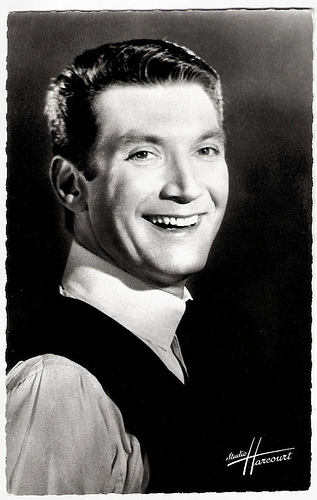
French postcard by Edition du Globe (EDUG), Paris, no. 698. Photo: Studio Harcourt.
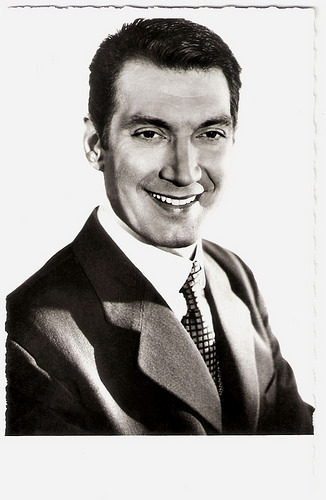
French postcard by Editions P.I., Paris, no. 1093, offered by Les Carbones Korès 'Carboplane'. Photo: Marcel Bouguereau.
Nouvelle Vague classic
Félix Marten started a second career in the cinema. In 1946, he made his film debut in Rêves d'amour/Love Dreams (Christian Stengel, 1947) in which Pierre Richard Willm starred as piano virtuoso and composer Franz Liszt.
In the next decades, Marten appeared in many French films and played opposite such major stars as Martine Carol , Michèle Morgan and Jean Gabin .
Among his best known films are the Nouvelle Vague classic Ascenseur pour l'échafaud/Elevator to the Gallows (Louis Malle, 1958) starring Jeanne Moreau and Maurice Ronet , Le Saint Mène La Danse/The Dance of Death (Jacques Nahum, 1960) in which he starred as Simon ‘The Saint’ Templar, and Paris brûle-t-il?/Is Paris burning? (René Clément, 1968) with Jean-Paul Belmondo .
However, his film appearances were mostly brief and seem forgotten now. Although his singing career suffered, he kept touring through the world.
In 1989 he retired after a final concert at the Casino de Paris. That same year, he also appeared one more time on the screen in an old Scopitone film that was integrated in Il y a des jours et des lunes/There Were Days... and Moons (Claude Lelouch, 1989). It was a Scopitone clip for the song La Rigolade (The Joke) that had been directed by Claude Lelouch in 1961.
At the age of 73, Félix Marten died in 1992 in Saint-Cloud, France, of a pulmonary embolism. He was divorced twice. His last wife was Fabienne Godard.
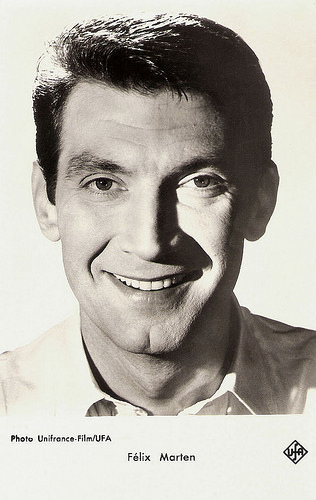
French postcard by Editions P.I., Paris, no. FK 59 A, offered by Les Carbones Korès 'Carboplane'. Photo: Unifrance-Film / Ufa.
Scopitone clip for the song La Rigolade (The Joke). Source: hebephreniac1 (YouTube).
Sources: Wikipedia (French and German) and .

French postcard by Editions P.I., Paris, no. 2336. Photo: Carla Menegol.
Arrested by the Gestapo
Paul Gabriel Félix Marten was born in Remagen, Germany, 1919. To flee Nazism and anti-Semitism, his family went in exile and took refuge in the Paris region.
Forced to start working young, Félix had all kind of jobs. First he became a salesman at Les Galeries Lafayette, only 15 years old. He also worked as a dockworker, a carpet dealer etc.
With his good looks, he dreamed to become an actor. On the advice of friends, he started to take lessons at the drama academy of Charles Dullin . Then war broke out and in 1944 the Gestapo arrested him and he had to do obligatory work in Germany.
After his return to France, he hoped to become a pop singer. He started to perform in cabarets in Paris and in the provinces and even abroad in Indochina.
Édith Piaf noticed him and gave him advise for his future career. He became known singing songs like La Mer and La Vie en Rose. Marten soon got engagements at the major venues in Paris, the Bobino and the Olympia.

French postcard by Edition du Globe (EDUG), Paris, no. 698. Photo: Studio Harcourt.

French postcard by Editions P.I., Paris, no. 1093, offered by Les Carbones Korès 'Carboplane'. Photo: Marcel Bouguereau.
Nouvelle Vague classic
Félix Marten started a second career in the cinema. In 1946, he made his film debut in Rêves d'amour/Love Dreams (Christian Stengel, 1947) in which Pierre Richard Willm starred as piano virtuoso and composer Franz Liszt.
In the next decades, Marten appeared in many French films and played opposite such major stars as Martine Carol , Michèle Morgan and Jean Gabin .
Among his best known films are the Nouvelle Vague classic Ascenseur pour l'échafaud/Elevator to the Gallows (Louis Malle, 1958) starring Jeanne Moreau and Maurice Ronet , Le Saint Mène La Danse/The Dance of Death (Jacques Nahum, 1960) in which he starred as Simon ‘The Saint’ Templar, and Paris brûle-t-il?/Is Paris burning? (René Clément, 1968) with Jean-Paul Belmondo .
However, his film appearances were mostly brief and seem forgotten now. Although his singing career suffered, he kept touring through the world.
In 1989 he retired after a final concert at the Casino de Paris. That same year, he also appeared one more time on the screen in an old Scopitone film that was integrated in Il y a des jours et des lunes/There Were Days... and Moons (Claude Lelouch, 1989). It was a Scopitone clip for the song La Rigolade (The Joke) that had been directed by Claude Lelouch in 1961.
At the age of 73, Félix Marten died in 1992 in Saint-Cloud, France, of a pulmonary embolism. He was divorced twice. His last wife was Fabienne Godard.

French postcard by Editions P.I., Paris, no. FK 59 A, offered by Les Carbones Korès 'Carboplane'. Photo: Unifrance-Film / Ufa.
Scopitone clip for the song La Rigolade (The Joke). Source: hebephreniac1 (YouTube).
Sources: Wikipedia (French and German) and .
Published on October 21, 2014 22:00
October 20, 2014
Bob Asklöf
Handsome Swedish singer, actor and model Bob Asklöf (1942-2011) was a yé-yé idol in France during the early 1960s. He also worked as an actor for film, stage and TV and in the 1970s he appeared nude in several French erotic films.

French postcard by E.D.U.G., presented by Les Carbones Korès Carboplane, no. 351. Photo: Gérard Neuvecelle.
From Russia with Love
Bob Holger Asklöf or Asklof was born in Motala, Sweden in 1942. From a young age on, he was always singing.
At 16, he left school and went to live in Stockholm. There he had singing and acting lessons. He was big, blonde and handsome and had an extraordinary voice. With the singing group The Glenners he went on tour.
At 19, he was spotted during a gig in Tel Aviv by Juliette Gréco , who invited him to come to Paris in December 1962. There, he became the winner of a contest organized by the record company Pathé-Marconi and the magazine Cinémonde.
His first hit in France was Vous souvenez-vous? (Do you remember?, 1963), and he became one of the yé-yé idols. Between 1963 and 1965, he recorded six ep’s and two albums.
One of his hits was Bons baisers de Russie, the French version of the title song of the film From Russia with Love (Terence Young, 1963). His version can be heard under the end titles in the French language version of the film.
In 1965, he participated at the festival de la Rose d'or d'Antibes (the Golden Rose festival of Antibes) and performed in France, Belgium and Switzerland.
Asklöf also sang in English, in German and Swedish. In between, he worked as a model for ads as for Sgigrand Covett clothes in 1964.
In 1965 and 1966, he recorded some songs in Sweden and made his film debut there as the young male lead in the Swedish-Danish erotic drama Ett sommaräventyr/Anna, My Darling (Håkan Ersgård, 1965).
Back in France, he played small parts in the films La Bande à Bonnot/Bonnot's Gang (Philippe Fourastié, 1968) with Jacques Brel , and the Hollywood production The Sergeant (John Flynn, 1969), which was filmed in France. The Sergeant is an interesting drama starring Rod Steiger and John Philip Law about repressed homosexuality in the army.
Asklöf had another part in Tout peut arriver/Don't Be Blue (1969), the first film by director Philippe Labro, and he played the lead as a G.I. in Vietnam in the short film Rosee du Matin (Jean Dasque, 1971), which was shown in the Quinzaine des Realisateurs section at the Cannes Film Festival in 1971.
He also played a hitman in Comptes à rebours/Countdown (Roger Pigaut, 1971) starring Serge Reggiani , and a killer in the adventure film Boulevard du Rhum/Rum Runners (Robert Enrico, 1971) with Lino Ventura and Brigitte Bardot .
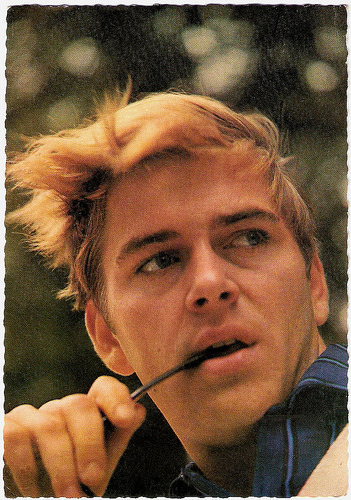
French postcard by Editions Starama, no. S-856. Photo: Patrick De Mervellec.
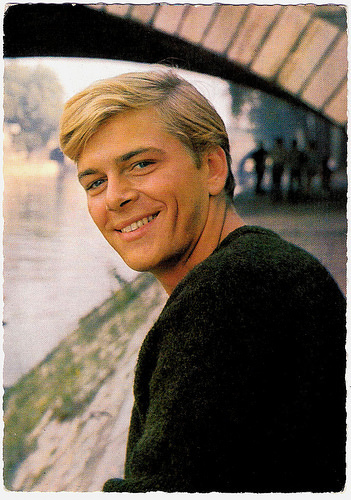
French postcard by E.D.U.G., no. 350. Photo: Gérard Neuvecelle / Disques Columbia.
A Marxist sexploitation movie
Bob Asklöf’s acting career in France took a surprising direction during the 1970s.
In 1973 the former teen idol played the leading part in Les tentations de Marianne/Marianne’s Temptations (Francis Leroi, 1973).
At IMDb , Timothy Tangs notes: “Marianne’s Temptations is that rare bird - a Marxist sexploitation movie. Originally part of a Godard-like post-68 revolutionary film collective, cash-strapped Francis Leroi decided to exploit the current French vogue for arty skinflicks to fund the struggle. Casting a papal niece in the lead, the film made a fortune, and paved the way for Emmanuelle.“
Asklöf also had a role in Anna Karina 's first attempt at writing and directing a film, Vivre ensemble/Living together (Anna Karina, 1973).
Asklöf was now much in demand for the sexploitation wave that splashed over the European cinema and he starred in soft core sex films like Quand les filles se déchaînent/Hot and Naked (Guy Maria, 1974), Les filles expertes/Expert Girls (Guy Maria, 1974) and Dora... la frénésie du plaisir/Dora ... the frenzy of pleasure (Willy Rozier, 1976) in which he was often shown full frontal nude.
His nom de plume in these films was Bob Holger. He kept appearing in small parts in mainstream films like the comedy C'est pas parce qu'on a rien à dire qu'il faut fermer sa gueule.../It is not because we have nothing to say that we must keep our mouth shut ... (Jacques Besnard, 1975) with Bernard Blier .
He also had a part in an episode of the popular TV series Les enquêtes du commissaire Maigret/The Investigations of Inspector Maigret (Jean Kerchbron, 1977) featuring Jean Richard as Maigret.
Asklöf appeared as a Nazi officer in Train spécial pour SS/Helltrain (Alain Payet, 1977). IMDb resumes the story as “The SS puts a slutty nightclub singer in charge of a train car full of prostitutes whose "services" are reserved solely for Adolf Hitler.”
This kind of Nazisploitation films were a bizarre and nasty subgenre of the soft core sex films of the 1970s. Big Willy and The Samurai at The Gentlemen’s blog to Midnite Cinema explain the subgenre: “These films typically showcase tons of skin (male and female) and sex, gruesome tortures, bloody violence, and humiliation. They are alternately set in brothels, prison camps, or a combination of the two.”
Asklöf also worked with director Serge Korber on films like Pornotissimo (1977). Korber mixed mainstream with adult films - credited as John Thomas.
One of Asklöf’s better sex films was Goodbye Emmanuelle (François Letterier, 1977) starring Sylvia Kristel . This third Emmanuelle episode tried to deal realistically with real-life, and potentially depressing issues like jealousy and abuse of women.
A reviewer at IMDb writes that in a way, Goodbye Emmanuelle marked the end of the free love era of the 1960s and 1970s. It also marked the end of Asklöf’s sex film career.
In 1977 he returned to Sweden, where he appeared in only one more film. He played ‘Gorilla’ in the thriller Flygnivå 450/Flight Level 450 (Torbjörn Axelman, 1980) with Thomas Hellberg. It was not a success.
He also did some stage work in Sweden, including a play about Edith Piaf , in which he interpreted her lover, boxer Marcel Cerdan .
In the 1980s, he left the acting profession to devote himself to his passion for painting and he had several exhibitions in Sweden. He also wrote poems and stories, which were never published.
After a long illness, Bob Asklöf died of cancer in 2011 in Bromma, Stockholm, Sweden.
Bob Asklöf sings I Who Have Nothing in a Swedish TV show. Source: Lesoufs (YouTube).
Bob Asklöf sings les grands boulevards in a French TV show in 1964. Source: Jcdesaintdenis (YouTube).
Sources: Official Bob Asklof blog, The Gentlemen’s blog to Midnite Cinema, French Films, Wikipedia (French), and .

French postcard by E.D.U.G., presented by Les Carbones Korès Carboplane, no. 351. Photo: Gérard Neuvecelle.
From Russia with Love
Bob Holger Asklöf or Asklof was born in Motala, Sweden in 1942. From a young age on, he was always singing.
At 16, he left school and went to live in Stockholm. There he had singing and acting lessons. He was big, blonde and handsome and had an extraordinary voice. With the singing group The Glenners he went on tour.
At 19, he was spotted during a gig in Tel Aviv by Juliette Gréco , who invited him to come to Paris in December 1962. There, he became the winner of a contest organized by the record company Pathé-Marconi and the magazine Cinémonde.
His first hit in France was Vous souvenez-vous? (Do you remember?, 1963), and he became one of the yé-yé idols. Between 1963 and 1965, he recorded six ep’s and two albums.
One of his hits was Bons baisers de Russie, the French version of the title song of the film From Russia with Love (Terence Young, 1963). His version can be heard under the end titles in the French language version of the film.
In 1965, he participated at the festival de la Rose d'or d'Antibes (the Golden Rose festival of Antibes) and performed in France, Belgium and Switzerland.
Asklöf also sang in English, in German and Swedish. In between, he worked as a model for ads as for Sgigrand Covett clothes in 1964.
In 1965 and 1966, he recorded some songs in Sweden and made his film debut there as the young male lead in the Swedish-Danish erotic drama Ett sommaräventyr/Anna, My Darling (Håkan Ersgård, 1965).
Back in France, he played small parts in the films La Bande à Bonnot/Bonnot's Gang (Philippe Fourastié, 1968) with Jacques Brel , and the Hollywood production The Sergeant (John Flynn, 1969), which was filmed in France. The Sergeant is an interesting drama starring Rod Steiger and John Philip Law about repressed homosexuality in the army.
Asklöf had another part in Tout peut arriver/Don't Be Blue (1969), the first film by director Philippe Labro, and he played the lead as a G.I. in Vietnam in the short film Rosee du Matin (Jean Dasque, 1971), which was shown in the Quinzaine des Realisateurs section at the Cannes Film Festival in 1971.
He also played a hitman in Comptes à rebours/Countdown (Roger Pigaut, 1971) starring Serge Reggiani , and a killer in the adventure film Boulevard du Rhum/Rum Runners (Robert Enrico, 1971) with Lino Ventura and Brigitte Bardot .

French postcard by Editions Starama, no. S-856. Photo: Patrick De Mervellec.

French postcard by E.D.U.G., no. 350. Photo: Gérard Neuvecelle / Disques Columbia.
A Marxist sexploitation movie
Bob Asklöf’s acting career in France took a surprising direction during the 1970s.
In 1973 the former teen idol played the leading part in Les tentations de Marianne/Marianne’s Temptations (Francis Leroi, 1973).
At IMDb , Timothy Tangs notes: “Marianne’s Temptations is that rare bird - a Marxist sexploitation movie. Originally part of a Godard-like post-68 revolutionary film collective, cash-strapped Francis Leroi decided to exploit the current French vogue for arty skinflicks to fund the struggle. Casting a papal niece in the lead, the film made a fortune, and paved the way for Emmanuelle.“
Asklöf also had a role in Anna Karina 's first attempt at writing and directing a film, Vivre ensemble/Living together (Anna Karina, 1973).
Asklöf was now much in demand for the sexploitation wave that splashed over the European cinema and he starred in soft core sex films like Quand les filles se déchaînent/Hot and Naked (Guy Maria, 1974), Les filles expertes/Expert Girls (Guy Maria, 1974) and Dora... la frénésie du plaisir/Dora ... the frenzy of pleasure (Willy Rozier, 1976) in which he was often shown full frontal nude.
His nom de plume in these films was Bob Holger. He kept appearing in small parts in mainstream films like the comedy C'est pas parce qu'on a rien à dire qu'il faut fermer sa gueule.../It is not because we have nothing to say that we must keep our mouth shut ... (Jacques Besnard, 1975) with Bernard Blier .
He also had a part in an episode of the popular TV series Les enquêtes du commissaire Maigret/The Investigations of Inspector Maigret (Jean Kerchbron, 1977) featuring Jean Richard as Maigret.
Asklöf appeared as a Nazi officer in Train spécial pour SS/Helltrain (Alain Payet, 1977). IMDb resumes the story as “The SS puts a slutty nightclub singer in charge of a train car full of prostitutes whose "services" are reserved solely for Adolf Hitler.”
This kind of Nazisploitation films were a bizarre and nasty subgenre of the soft core sex films of the 1970s. Big Willy and The Samurai at The Gentlemen’s blog to Midnite Cinema explain the subgenre: “These films typically showcase tons of skin (male and female) and sex, gruesome tortures, bloody violence, and humiliation. They are alternately set in brothels, prison camps, or a combination of the two.”
Asklöf also worked with director Serge Korber on films like Pornotissimo (1977). Korber mixed mainstream with adult films - credited as John Thomas.
One of Asklöf’s better sex films was Goodbye Emmanuelle (François Letterier, 1977) starring Sylvia Kristel . This third Emmanuelle episode tried to deal realistically with real-life, and potentially depressing issues like jealousy and abuse of women.
A reviewer at IMDb writes that in a way, Goodbye Emmanuelle marked the end of the free love era of the 1960s and 1970s. It also marked the end of Asklöf’s sex film career.
In 1977 he returned to Sweden, where he appeared in only one more film. He played ‘Gorilla’ in the thriller Flygnivå 450/Flight Level 450 (Torbjörn Axelman, 1980) with Thomas Hellberg. It was not a success.
He also did some stage work in Sweden, including a play about Edith Piaf , in which he interpreted her lover, boxer Marcel Cerdan .
In the 1980s, he left the acting profession to devote himself to his passion for painting and he had several exhibitions in Sweden. He also wrote poems and stories, which were never published.
After a long illness, Bob Asklöf died of cancer in 2011 in Bromma, Stockholm, Sweden.
Bob Asklöf sings I Who Have Nothing in a Swedish TV show. Source: Lesoufs (YouTube).
Bob Asklöf sings les grands boulevards in a French TV show in 1964. Source: Jcdesaintdenis (YouTube).
Sources: Official Bob Asklof blog, The Gentlemen’s blog to Midnite Cinema, French Films, Wikipedia (French), and .
Published on October 20, 2014 23:00
Paul van Yperen's Blog
- Paul van Yperen's profile
- 13 followers
Paul van Yperen isn't a Goodreads Author
(yet),
but they
do have a blog,
so here are some recent posts imported from
their feed.



